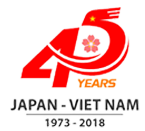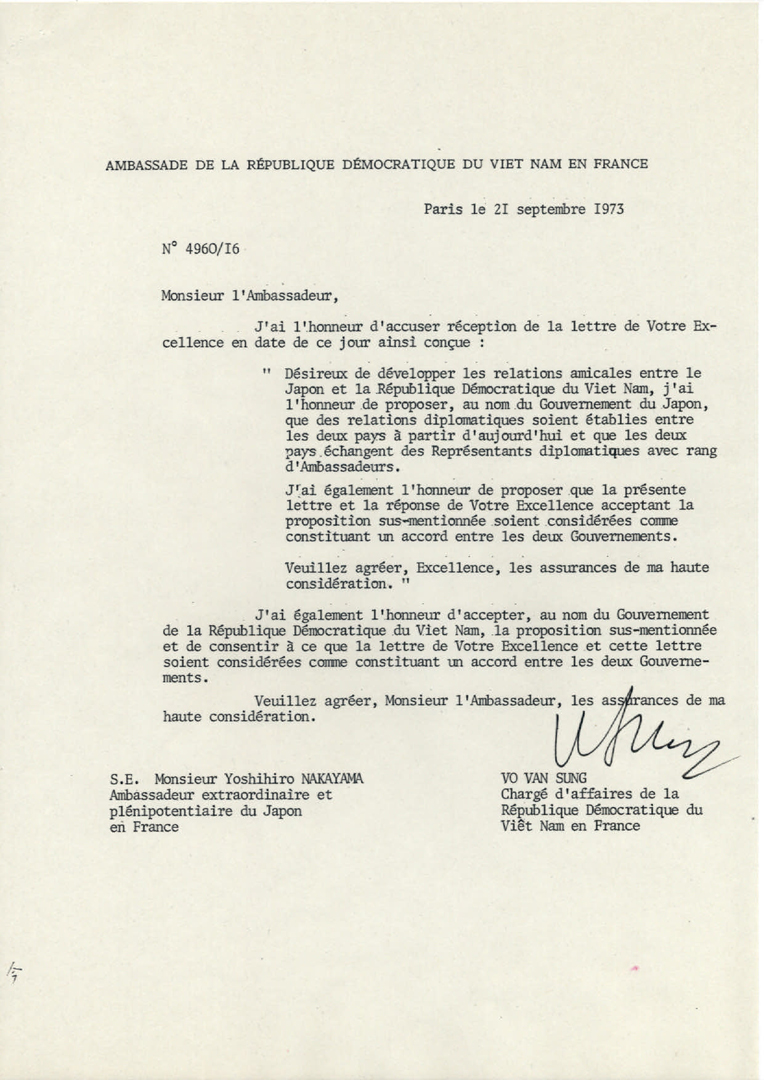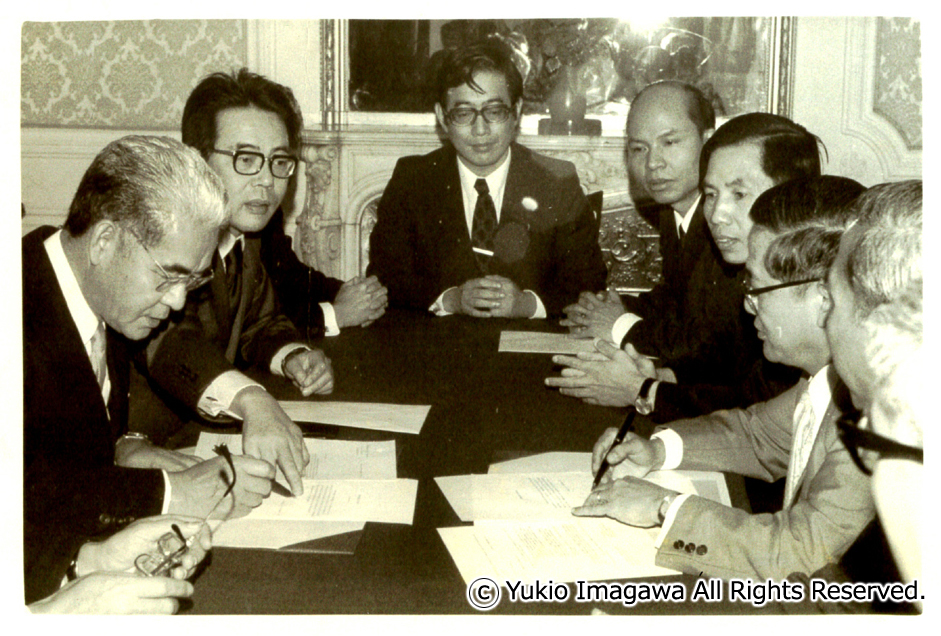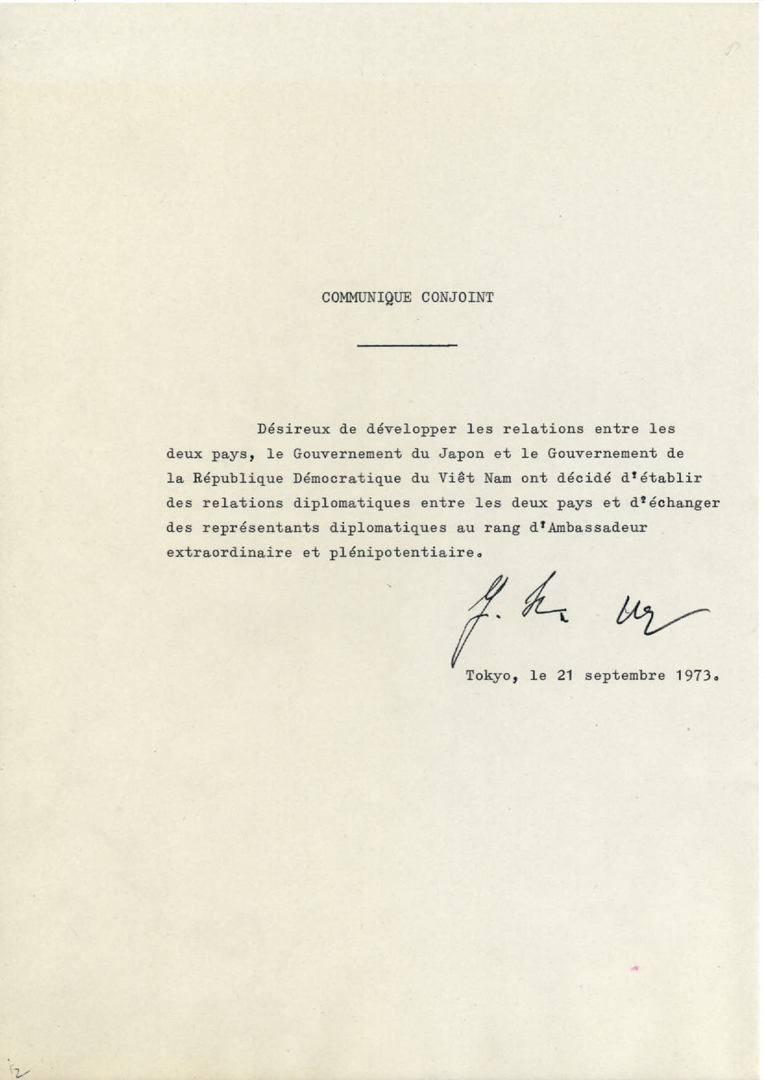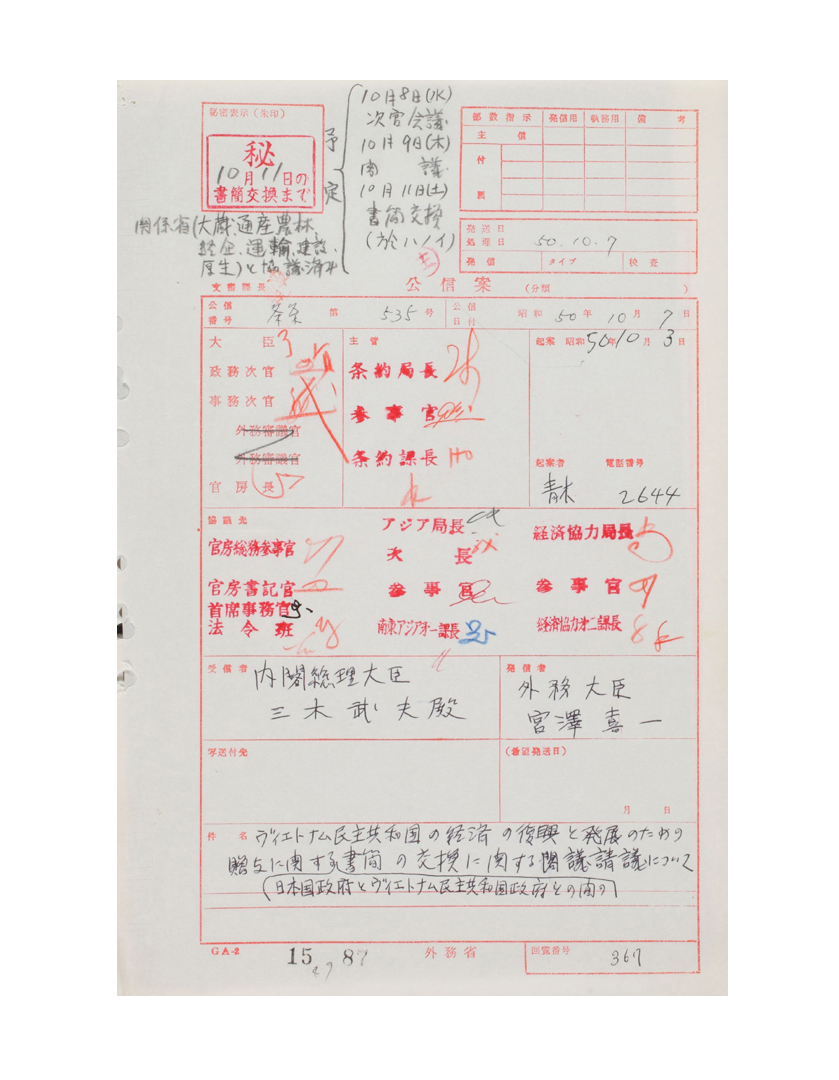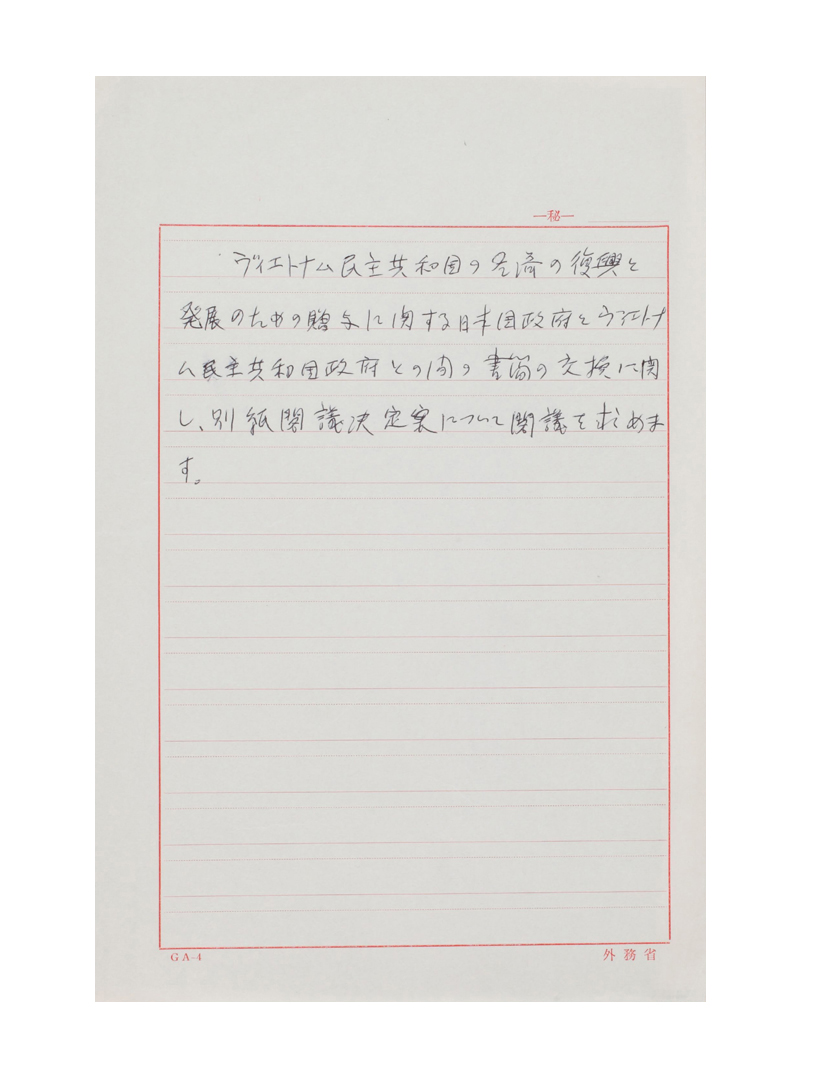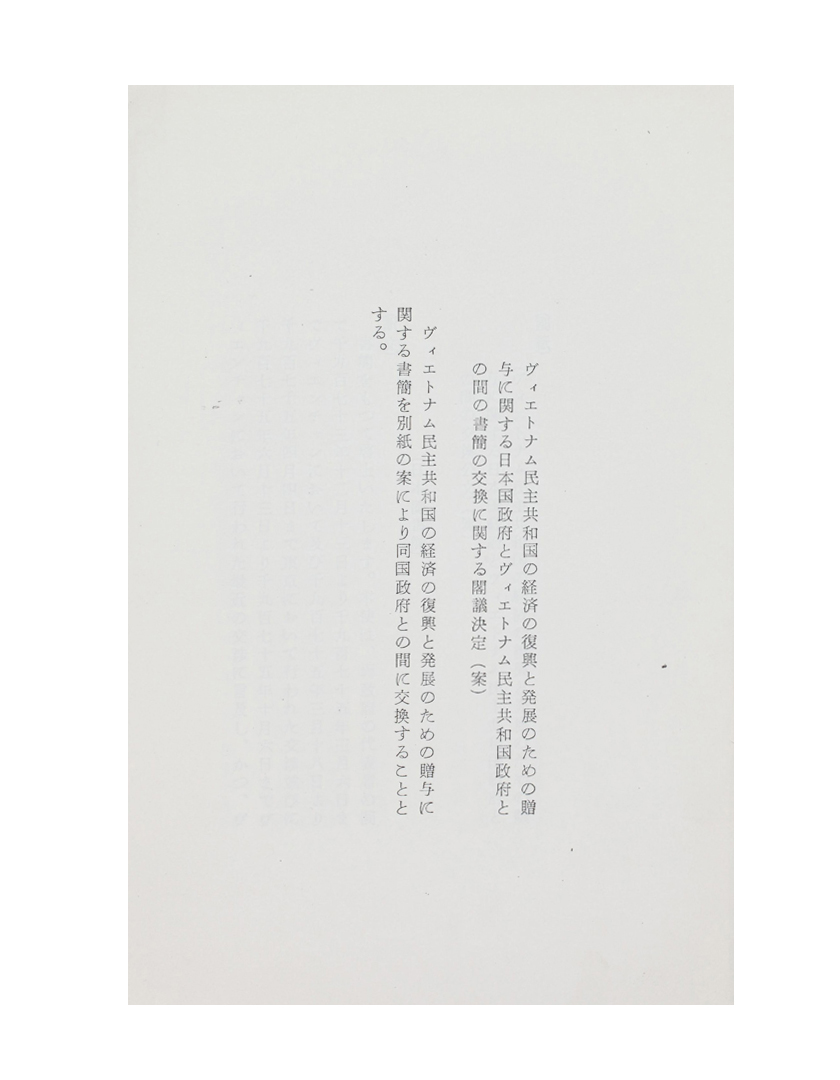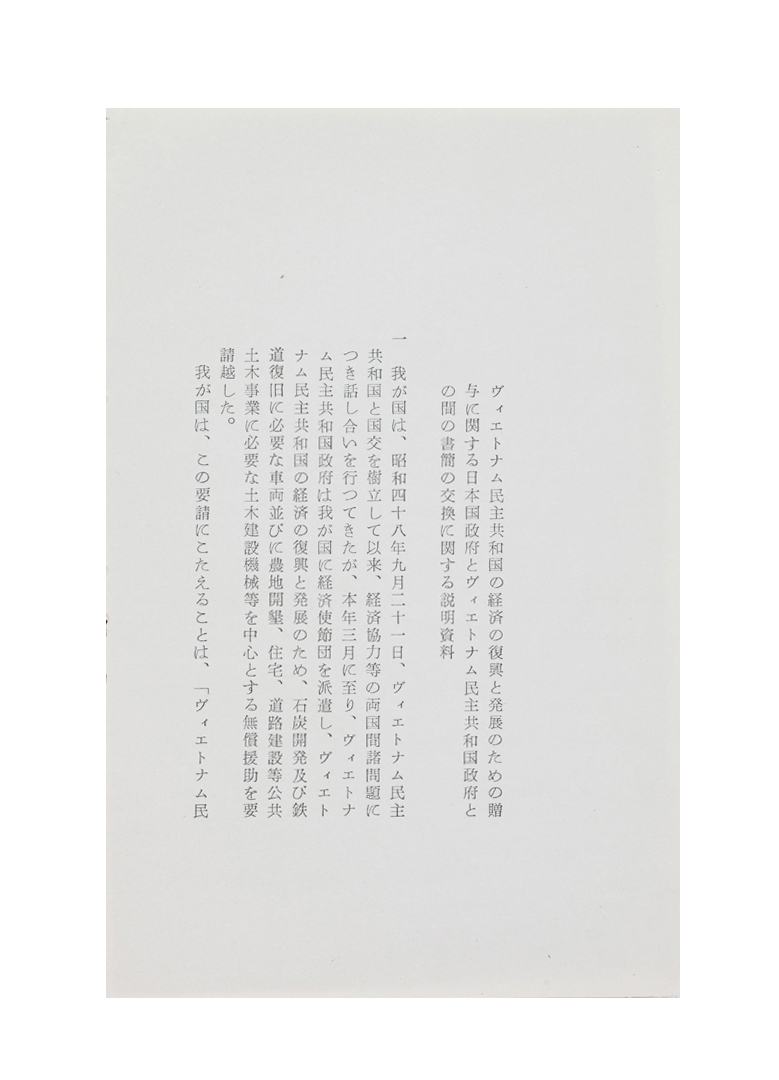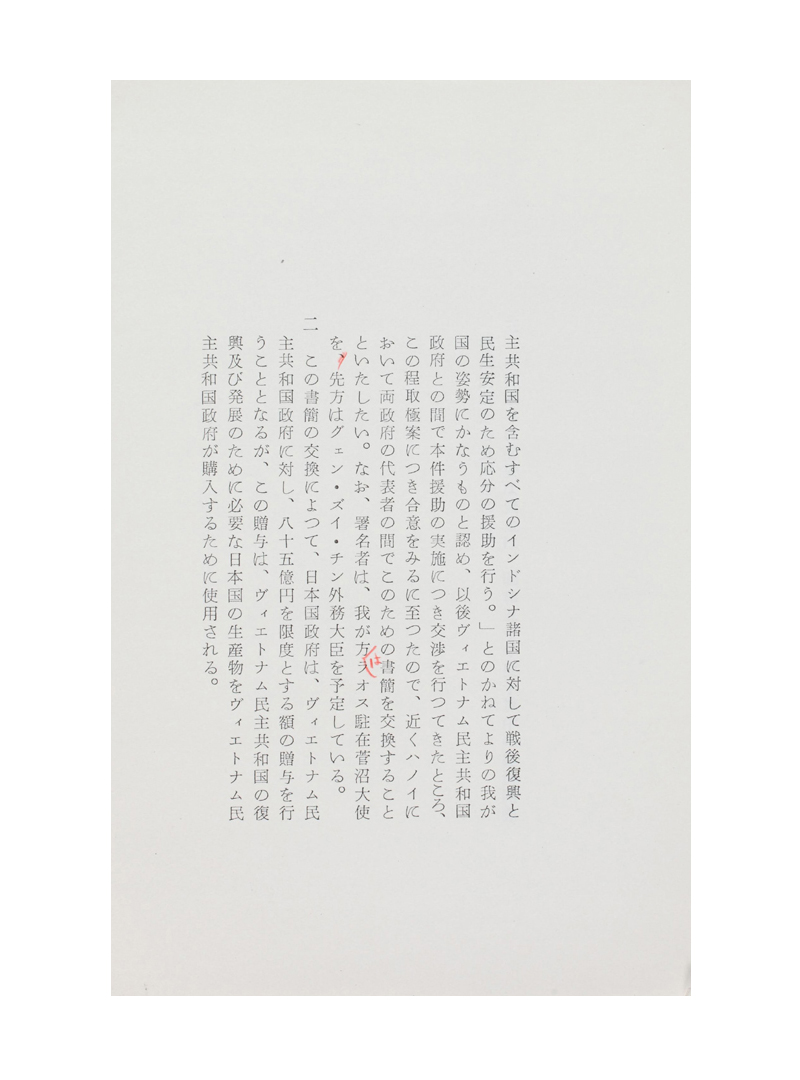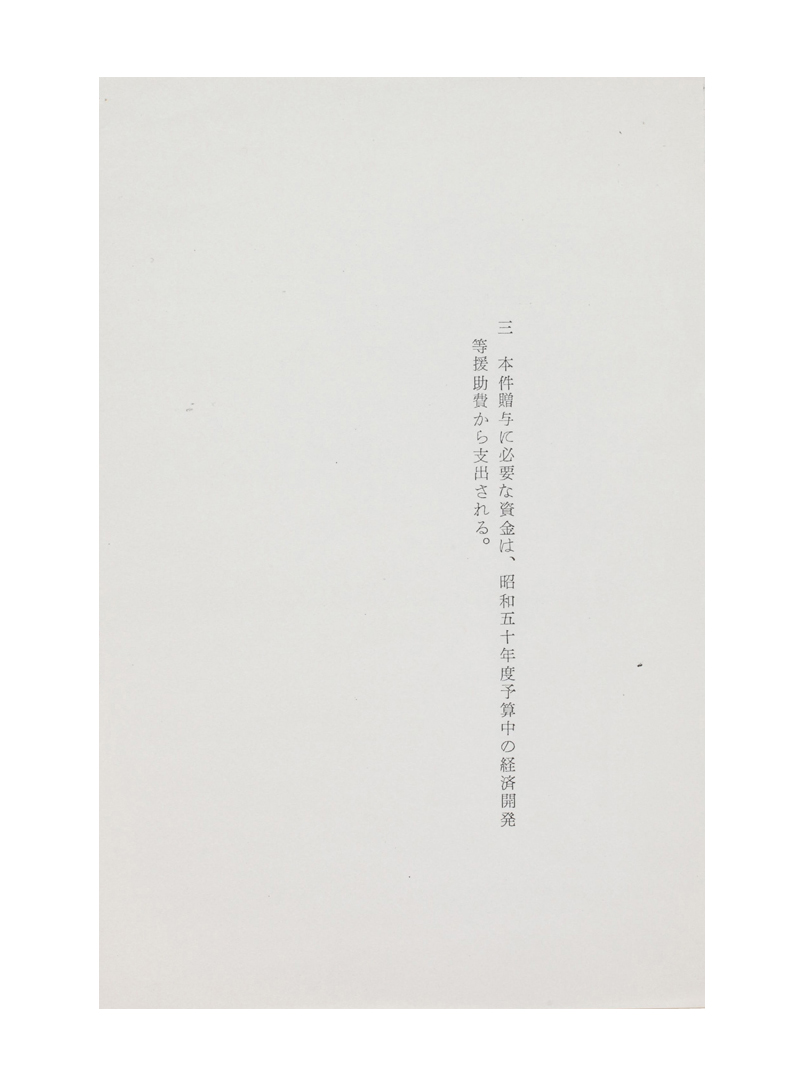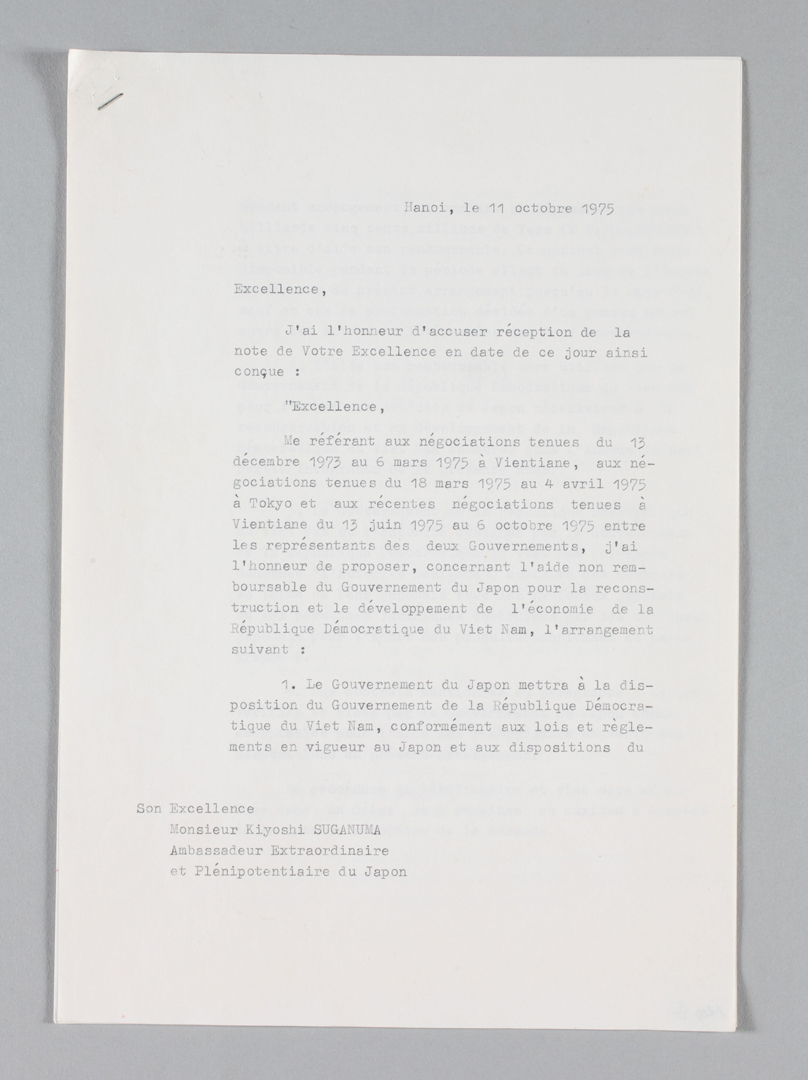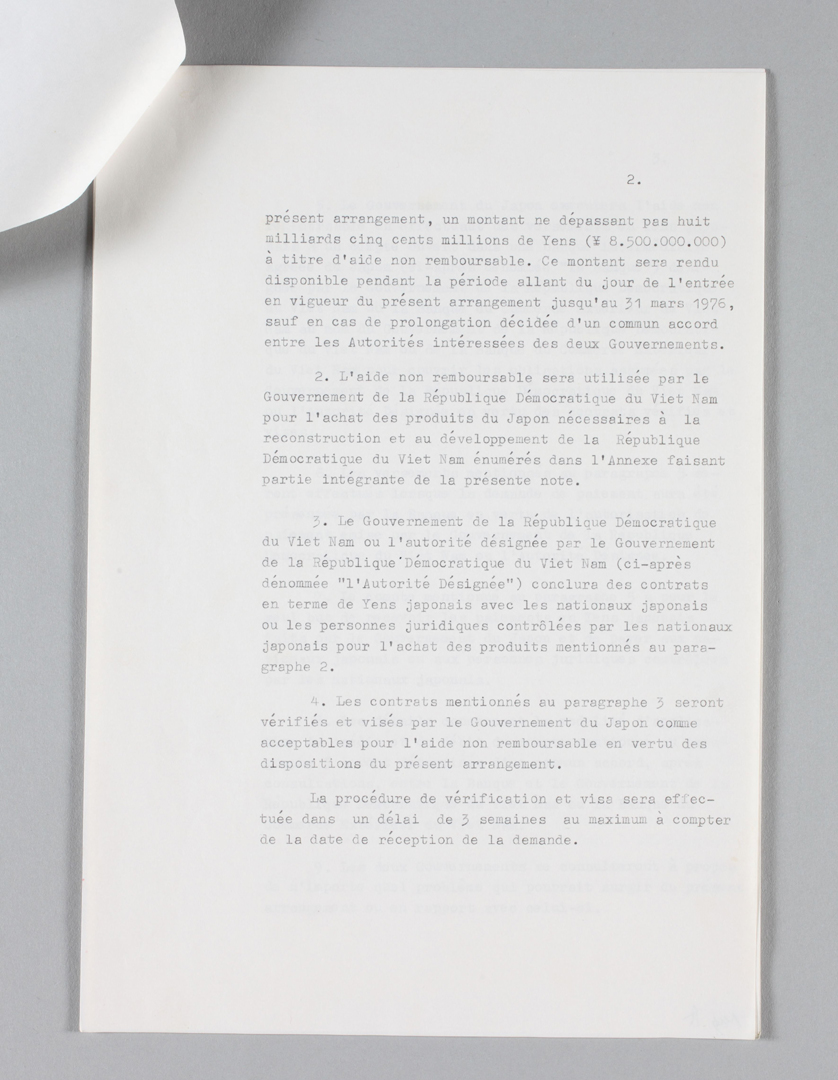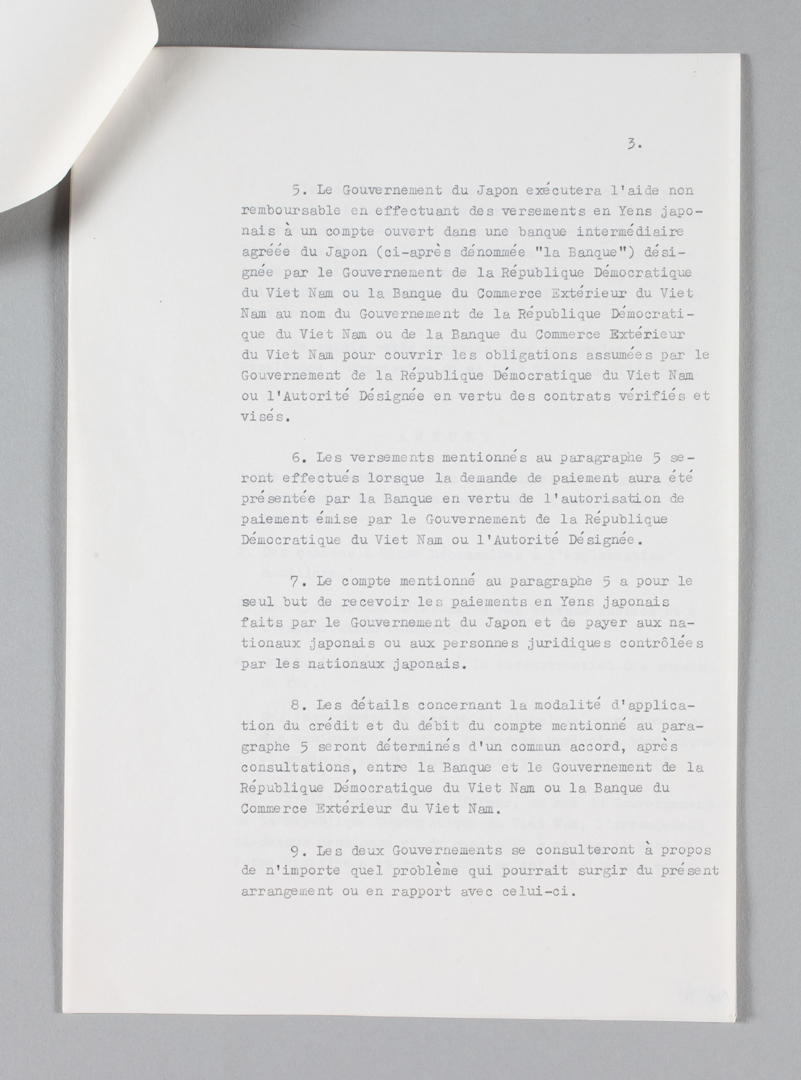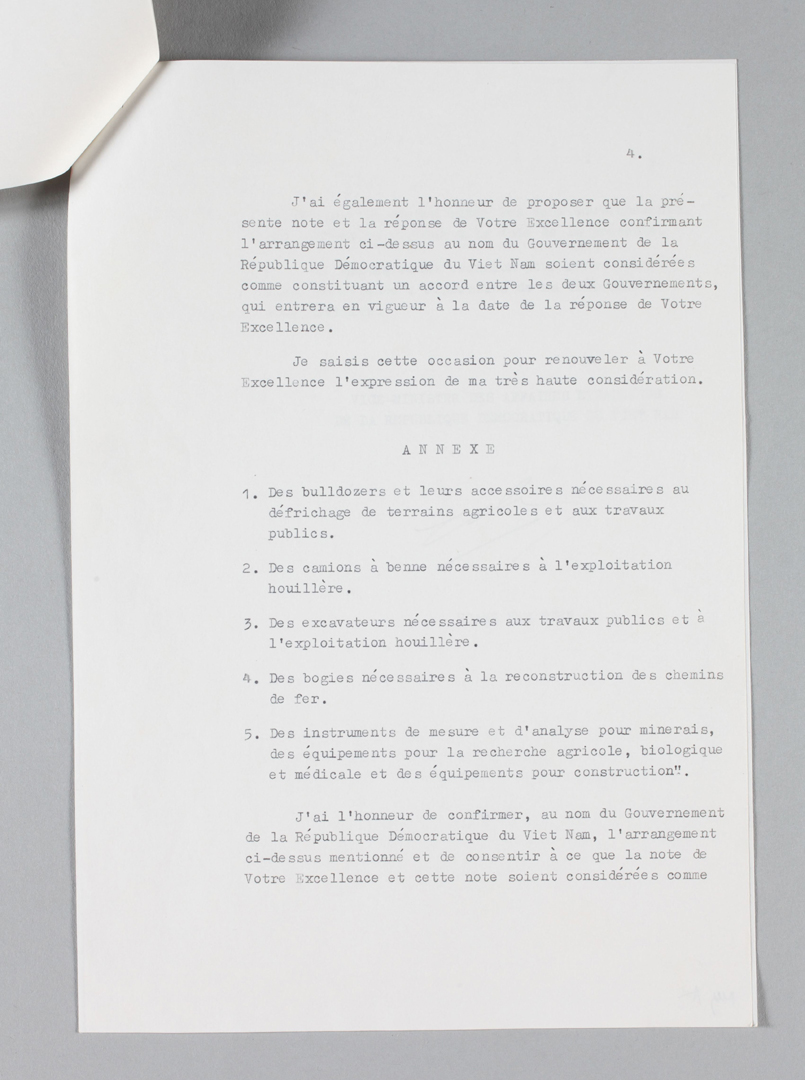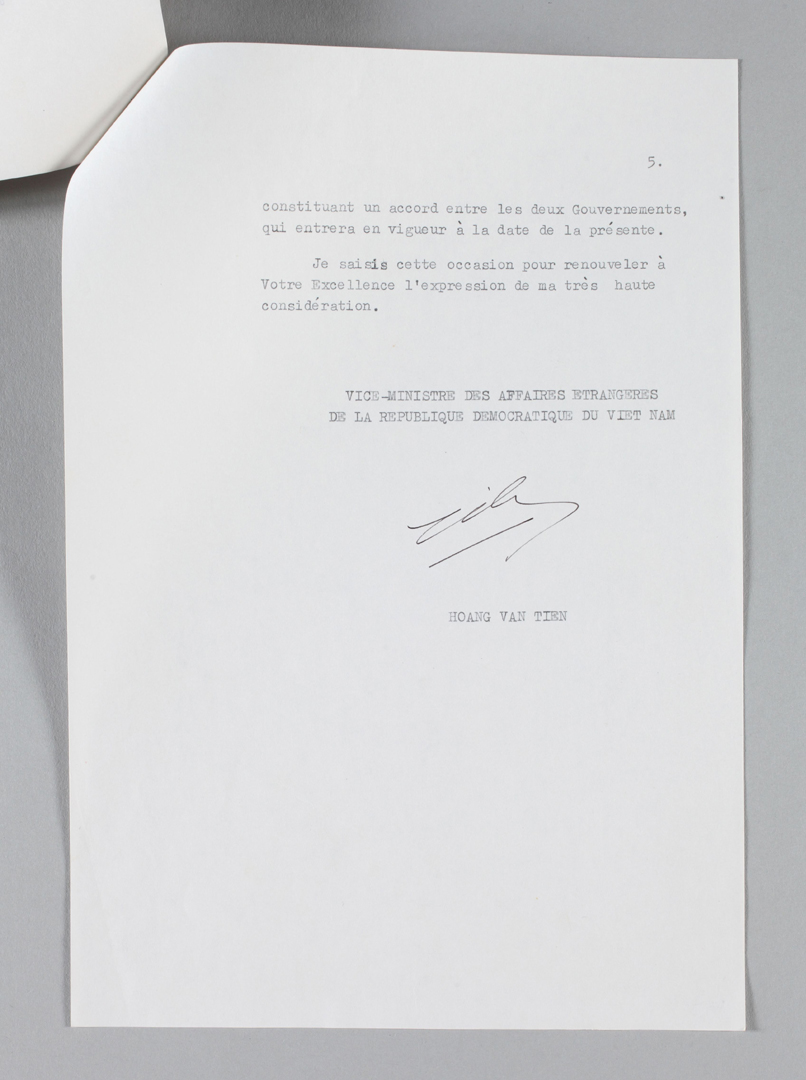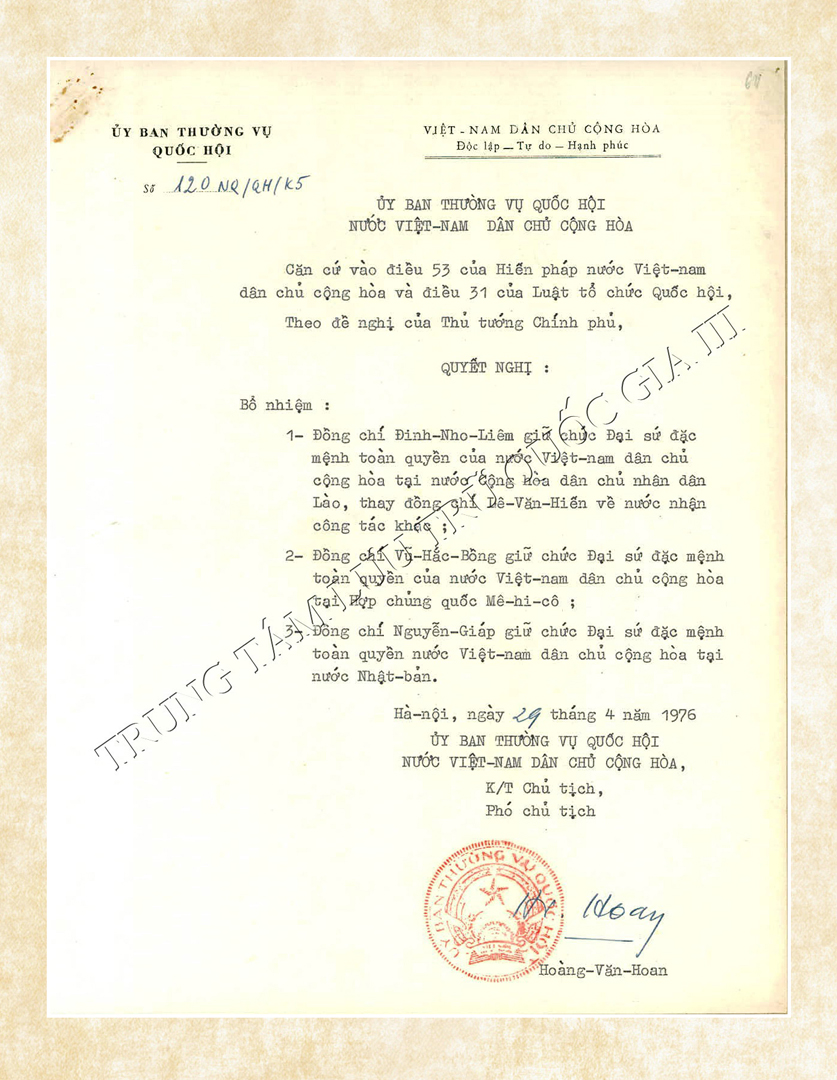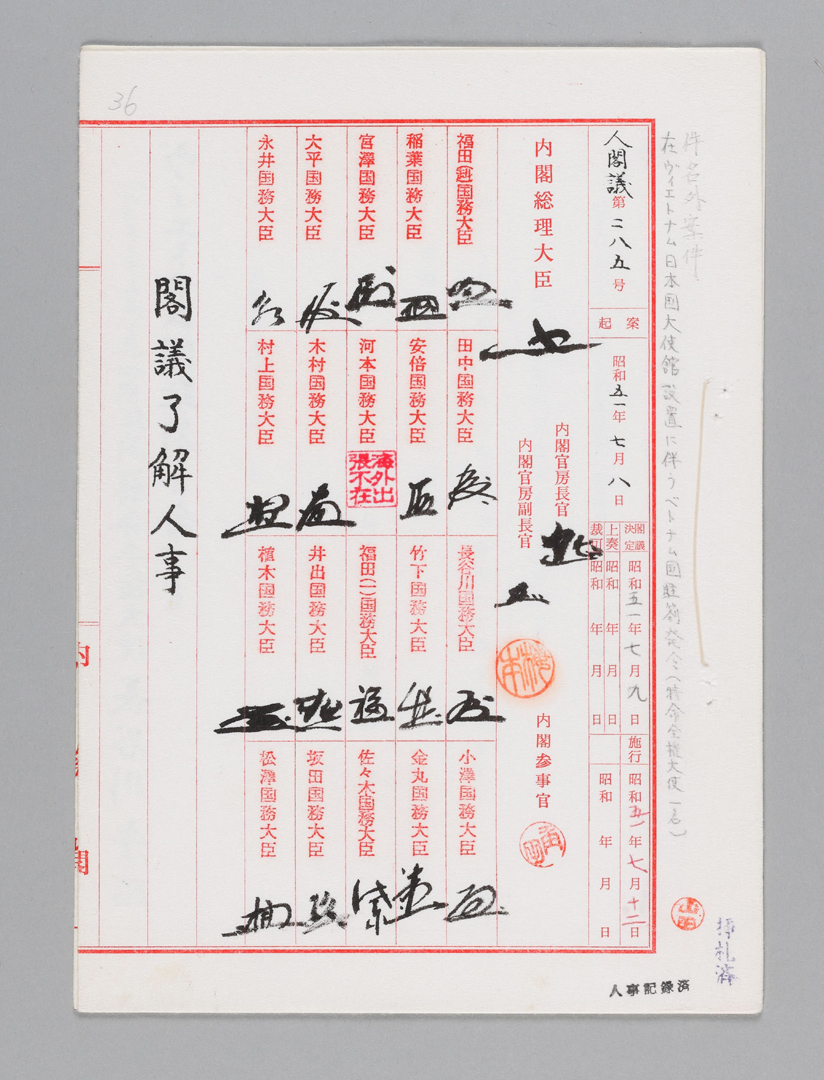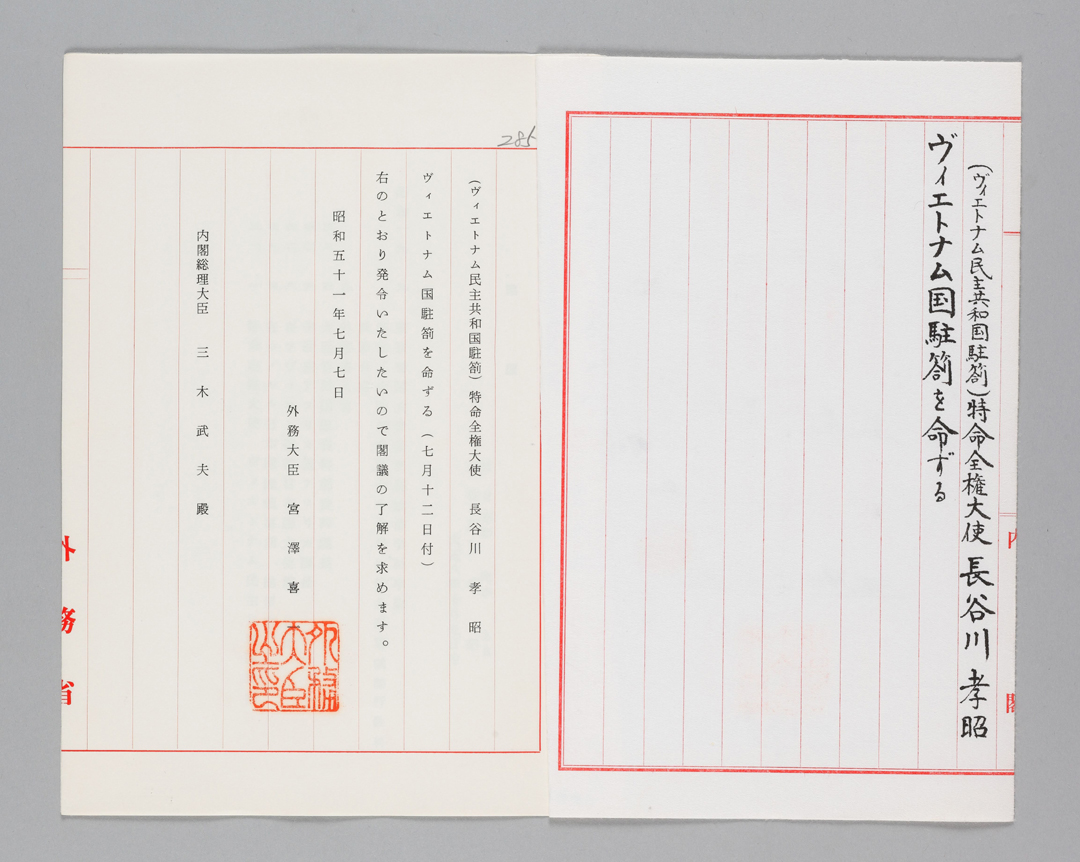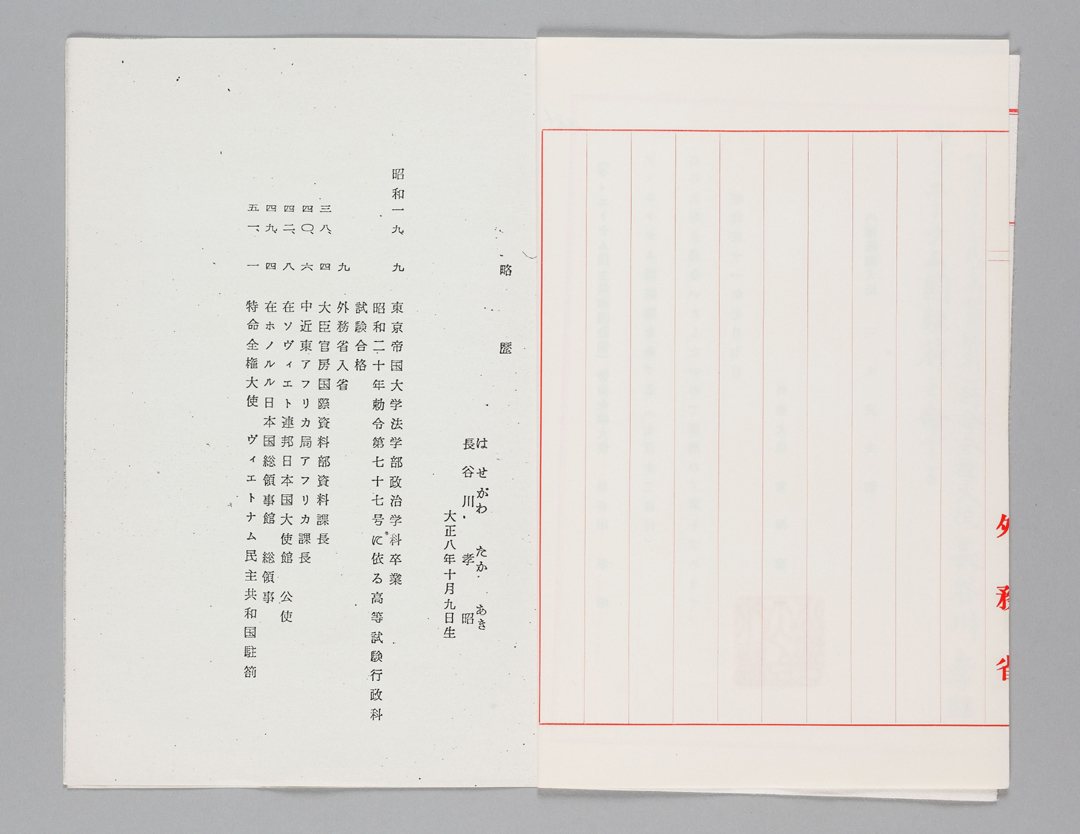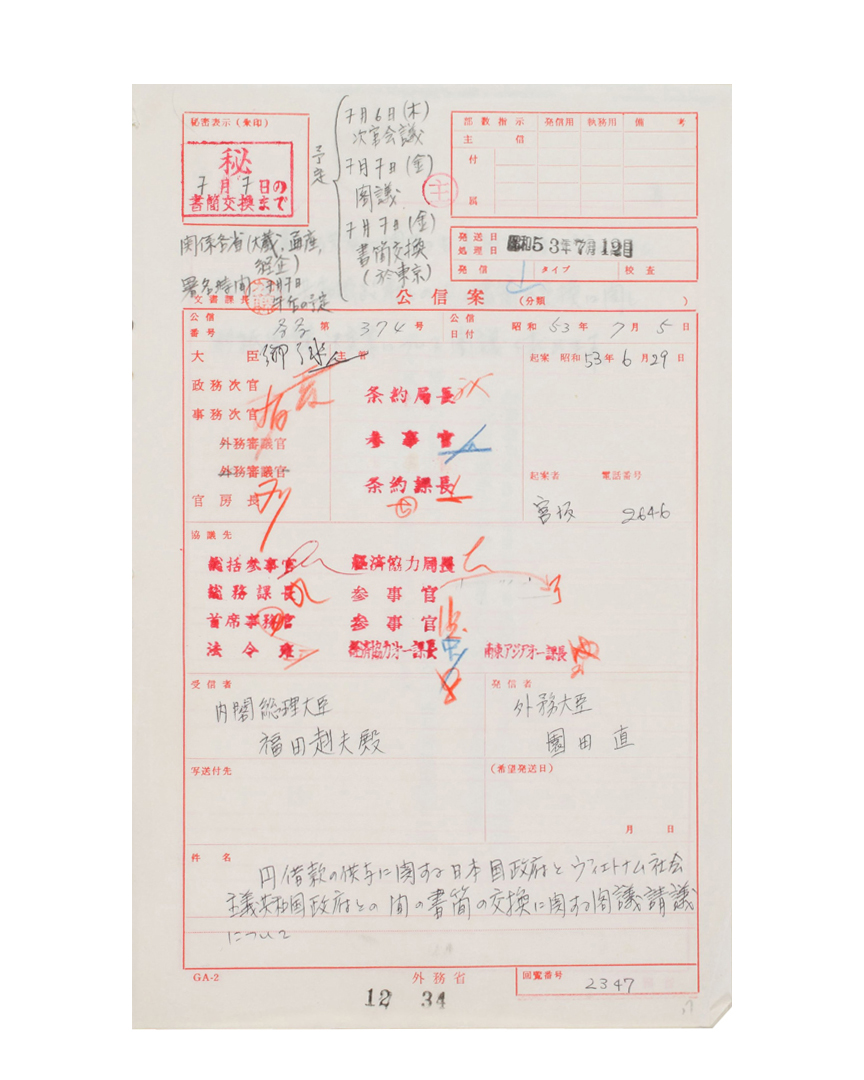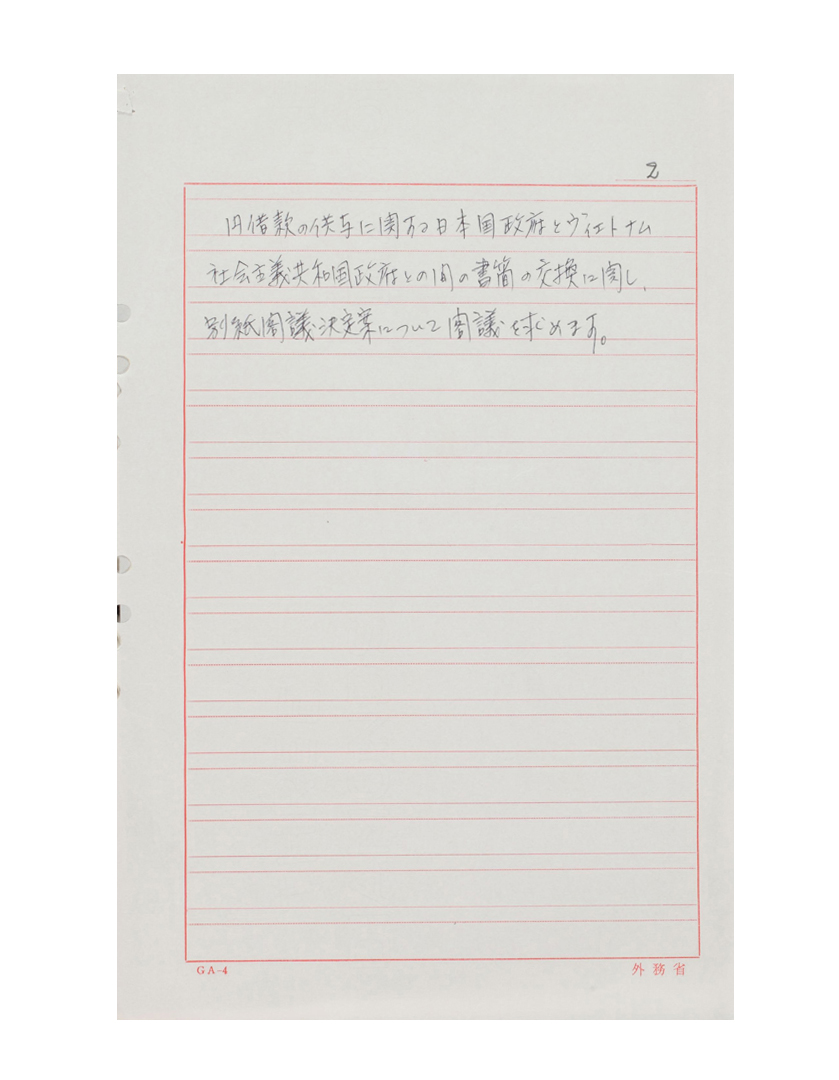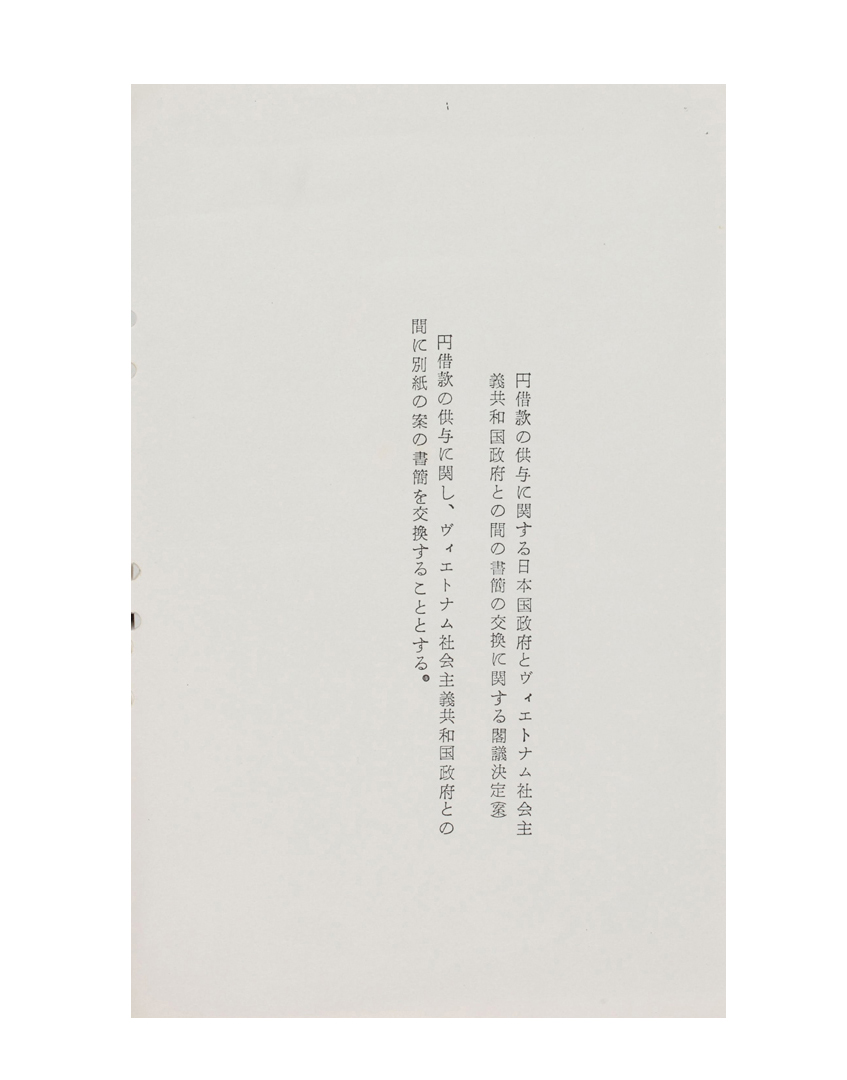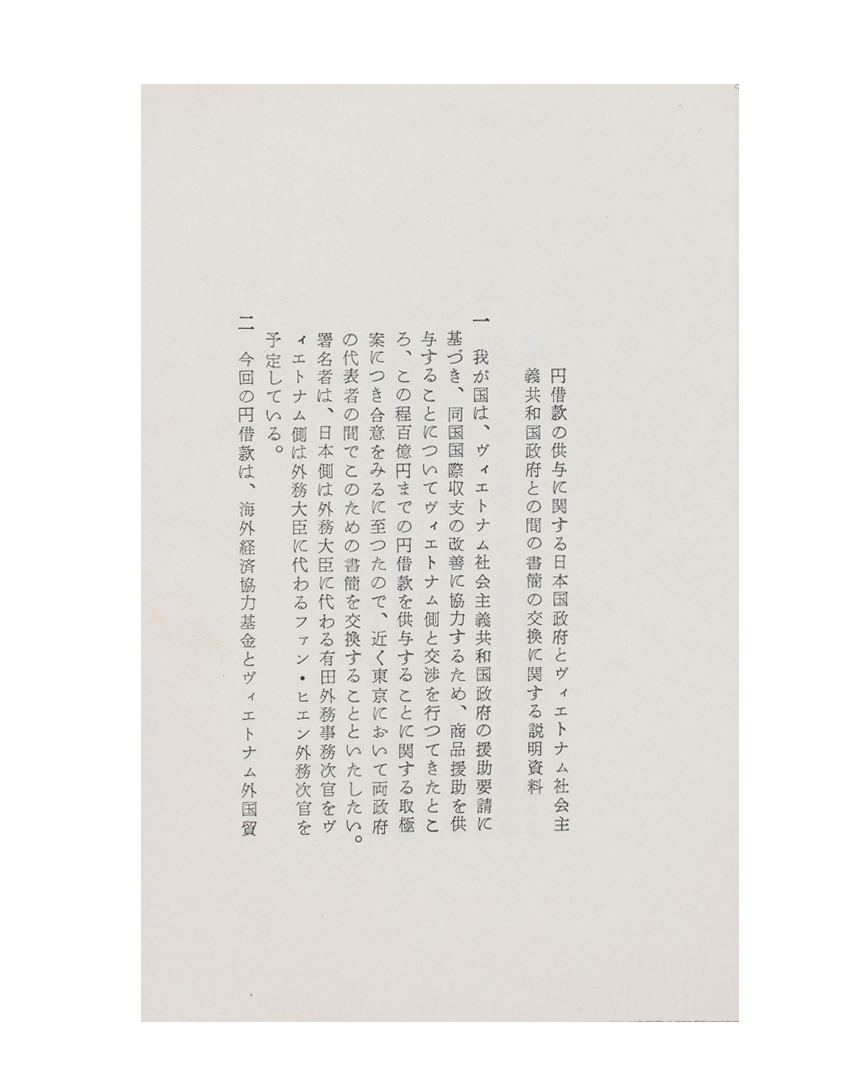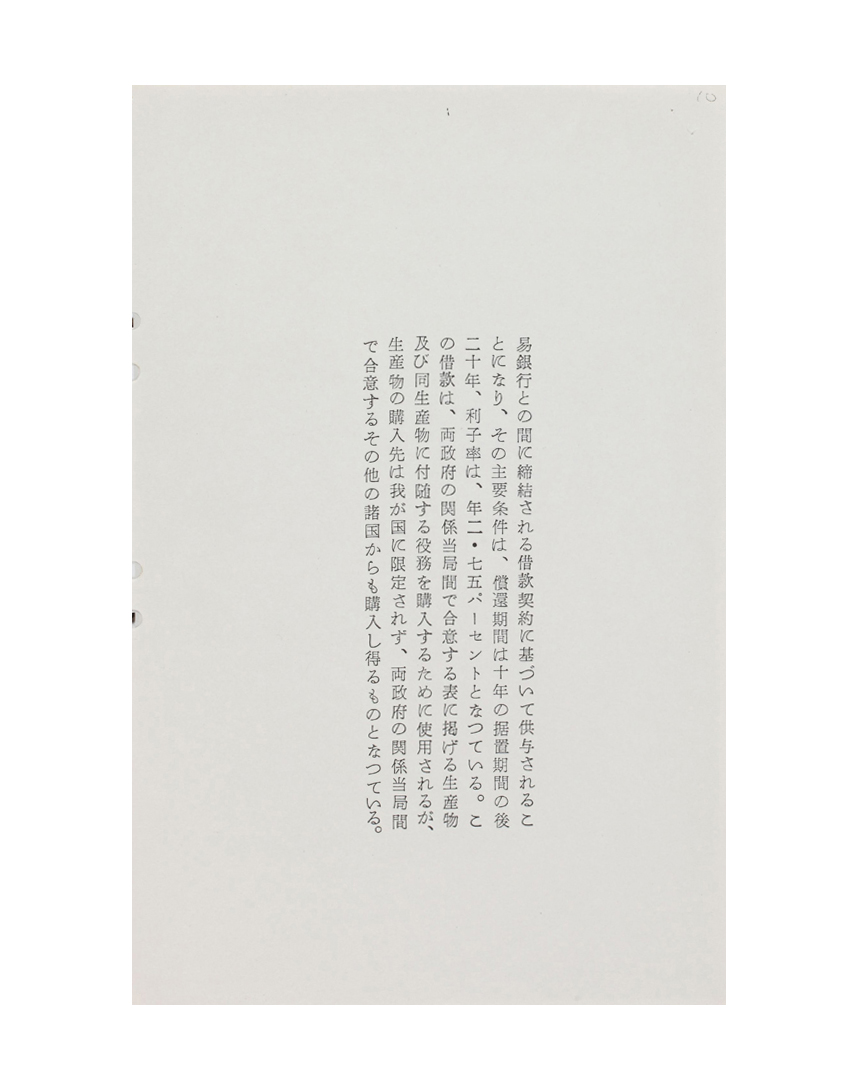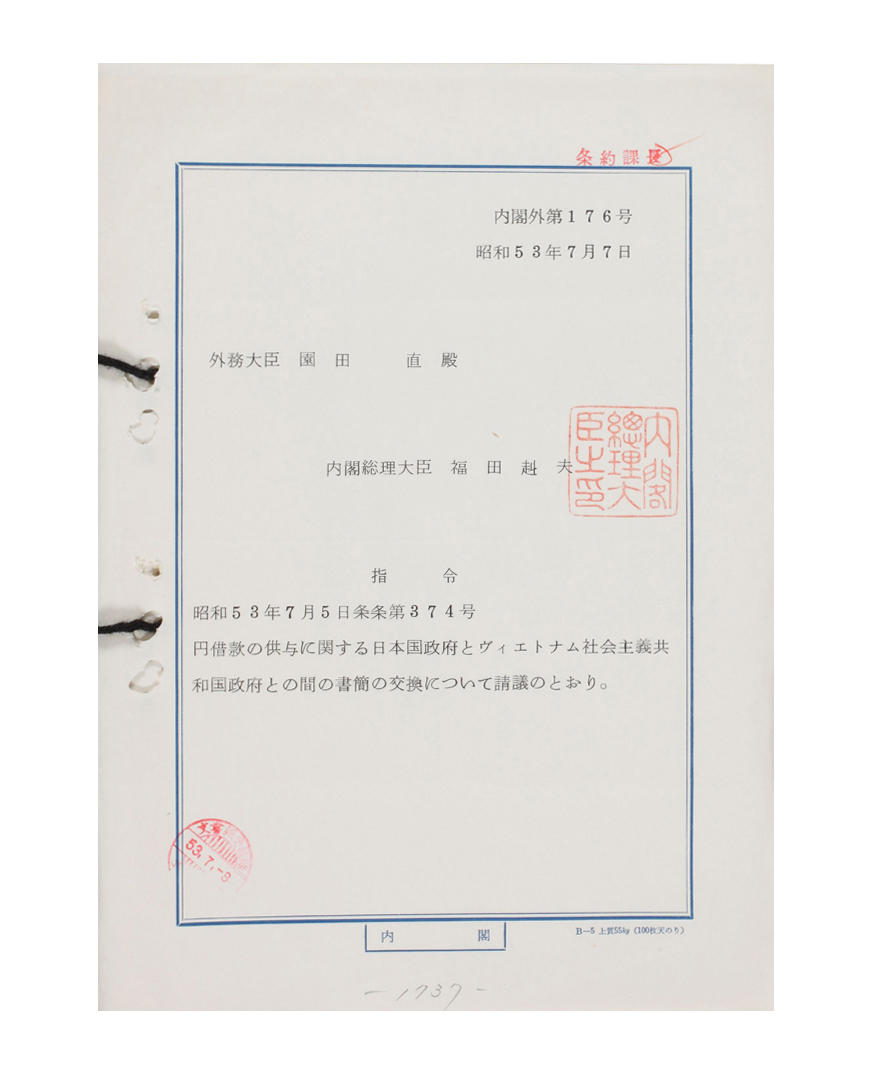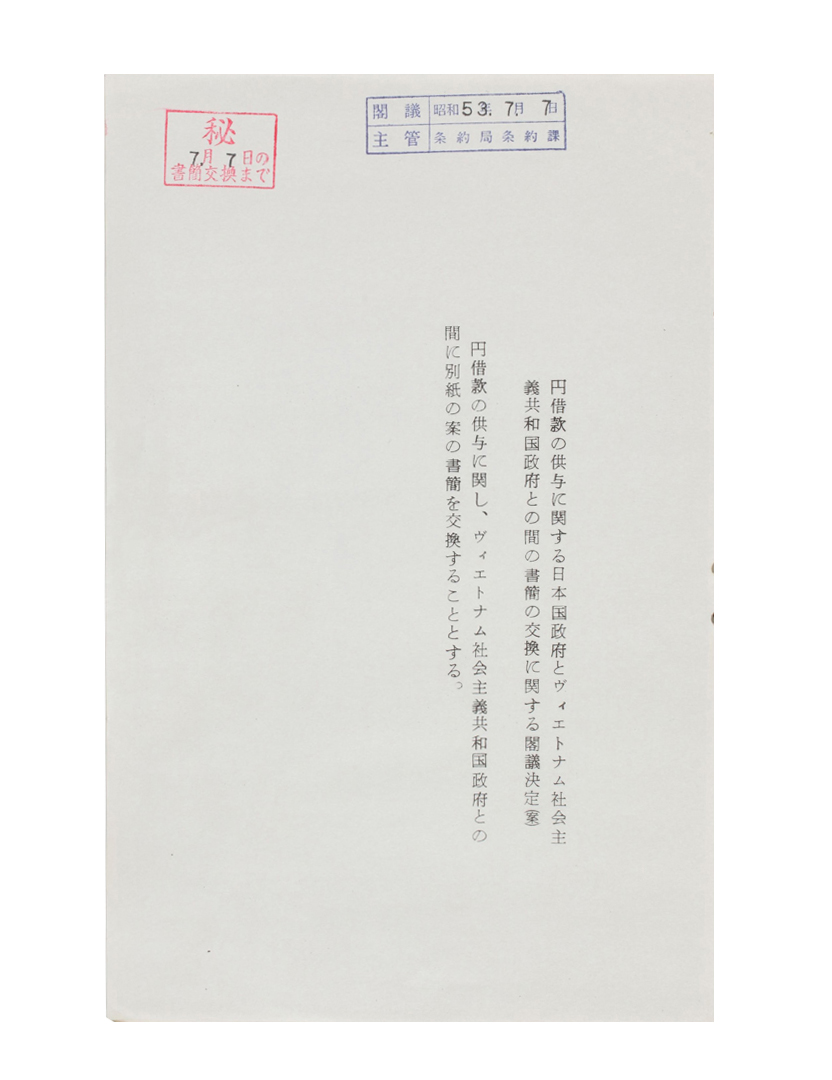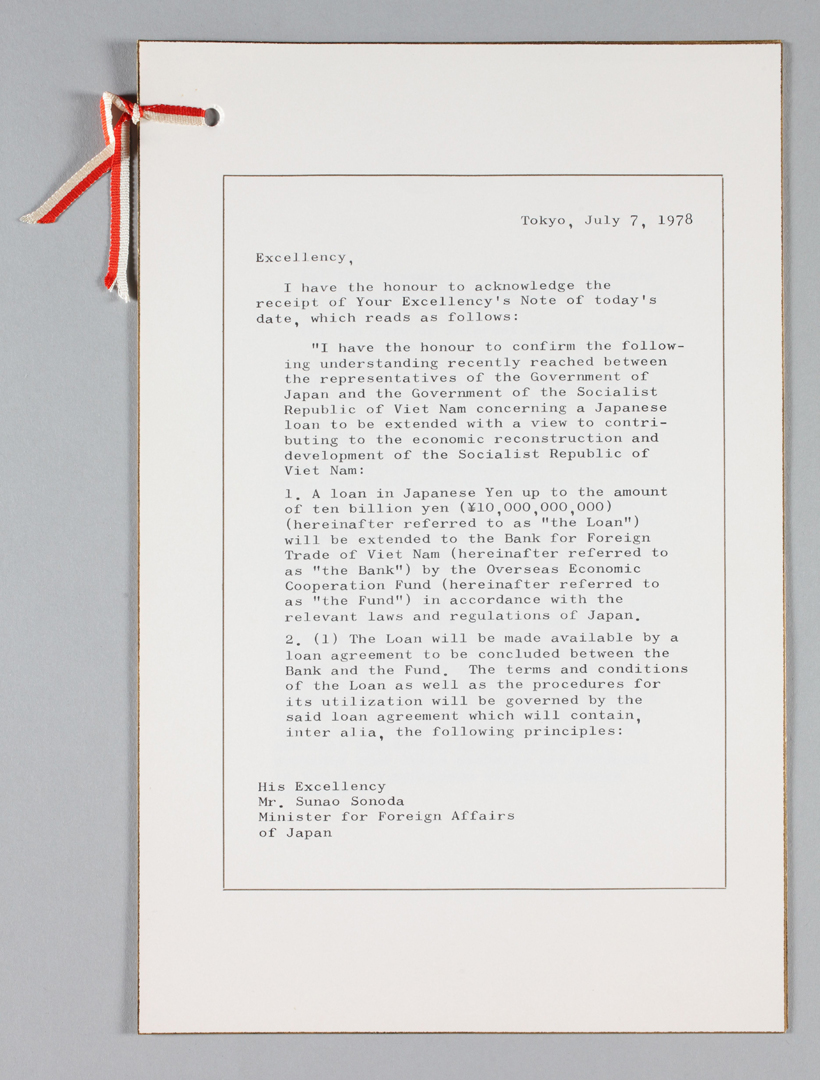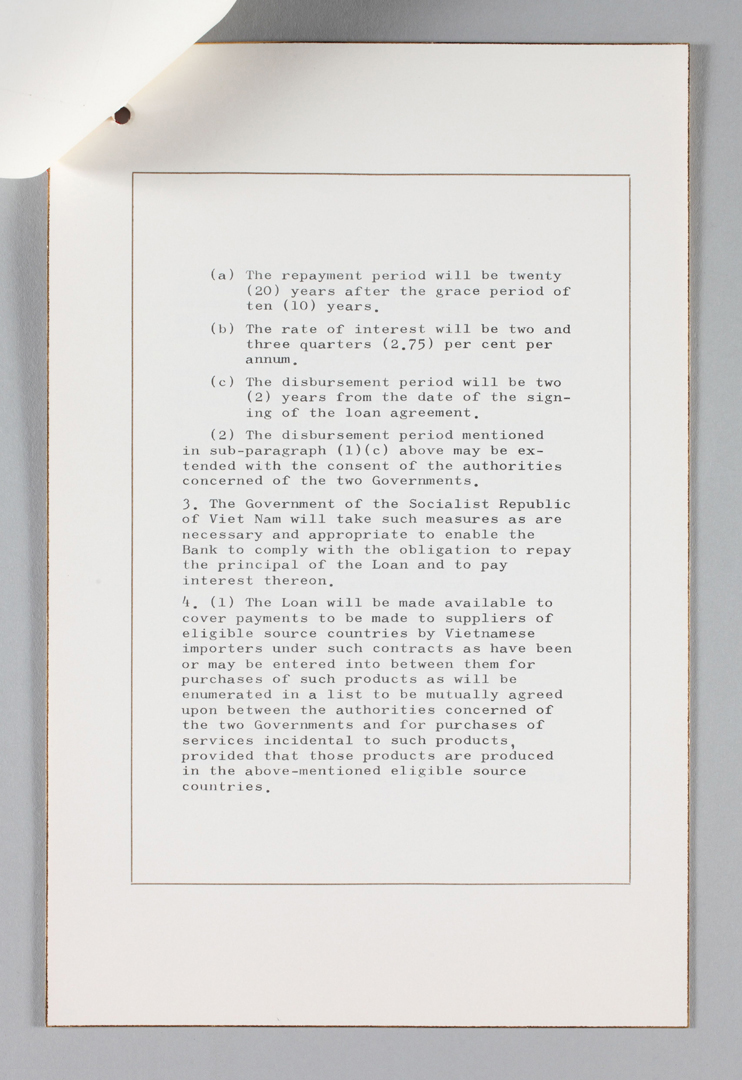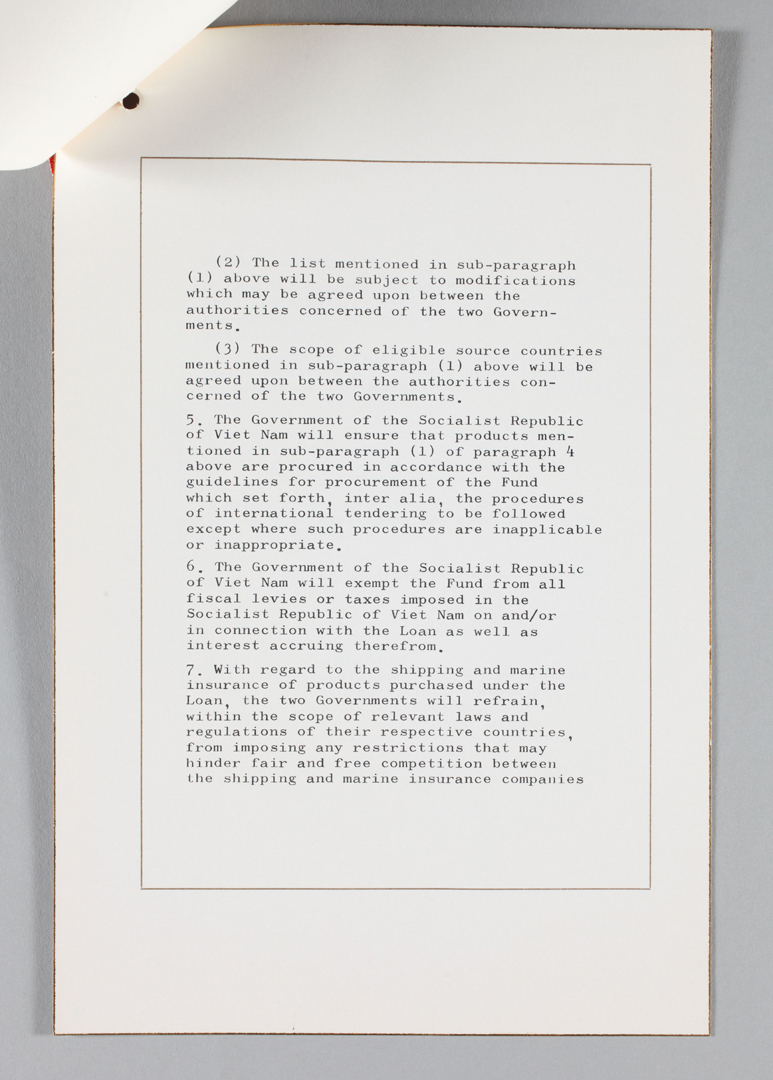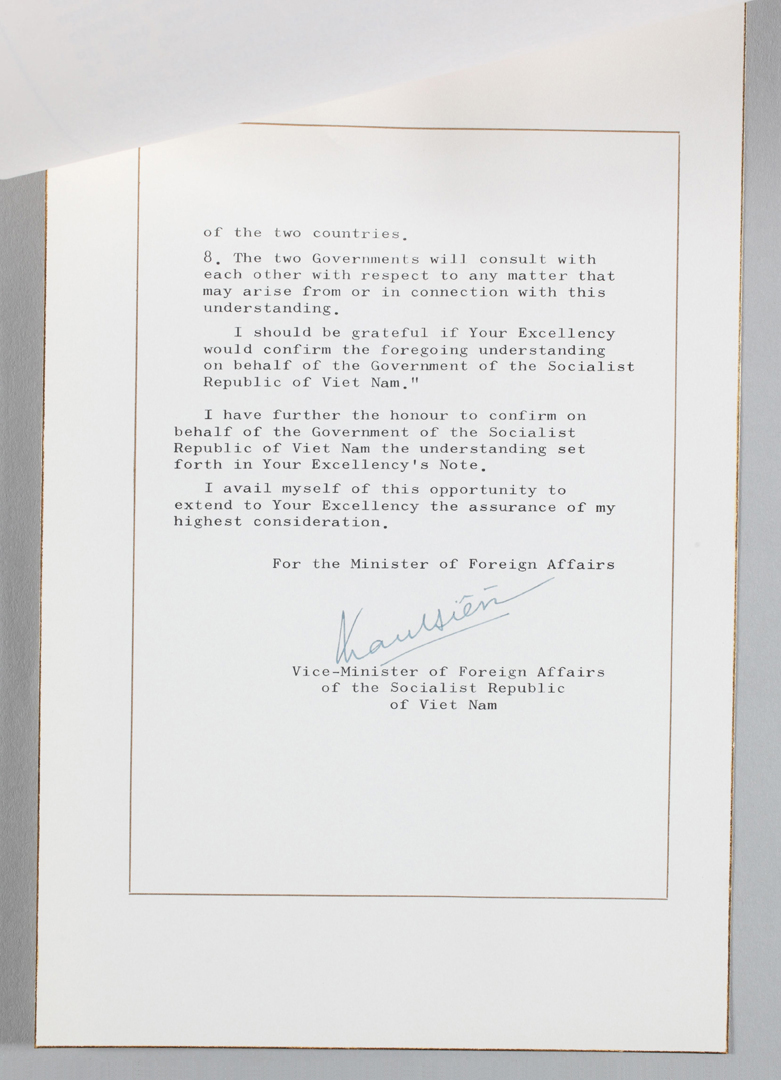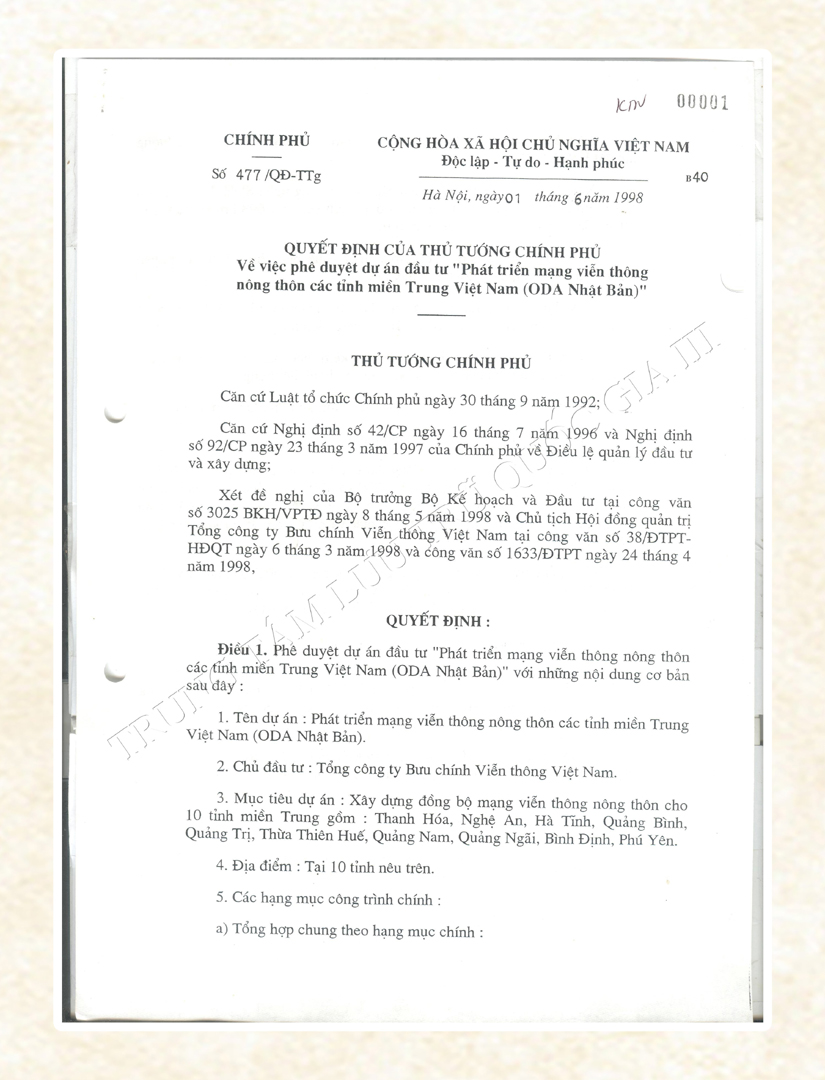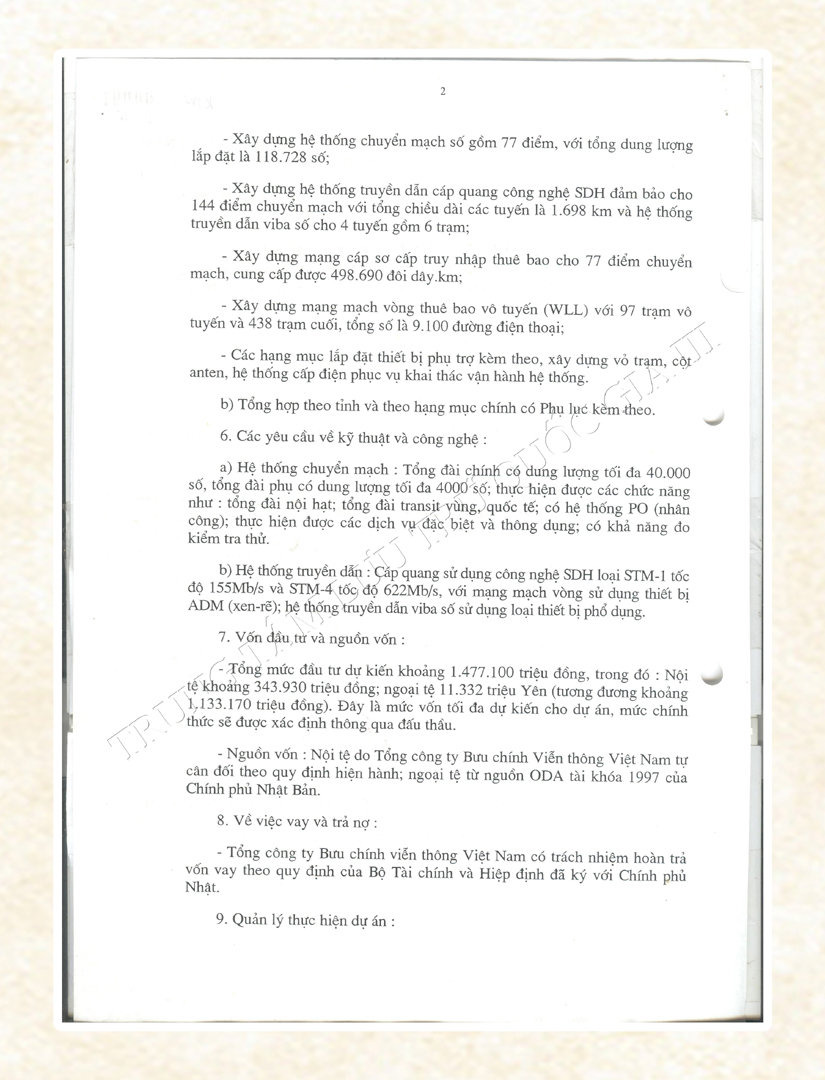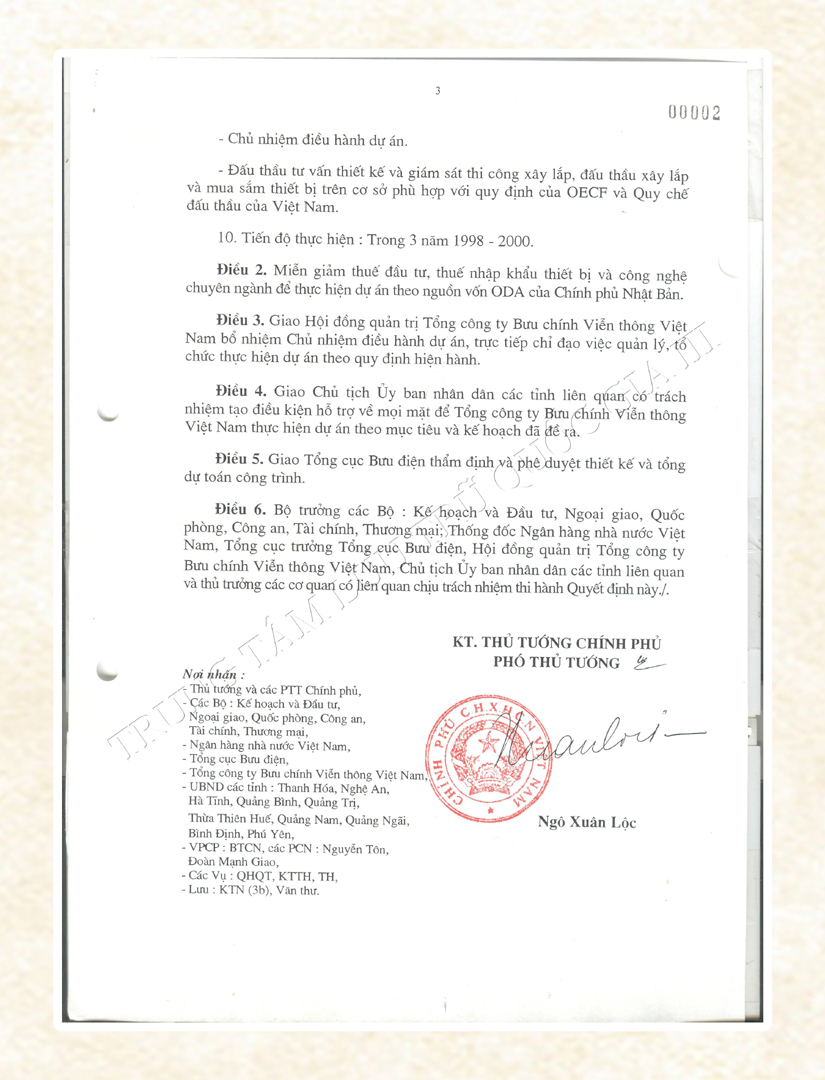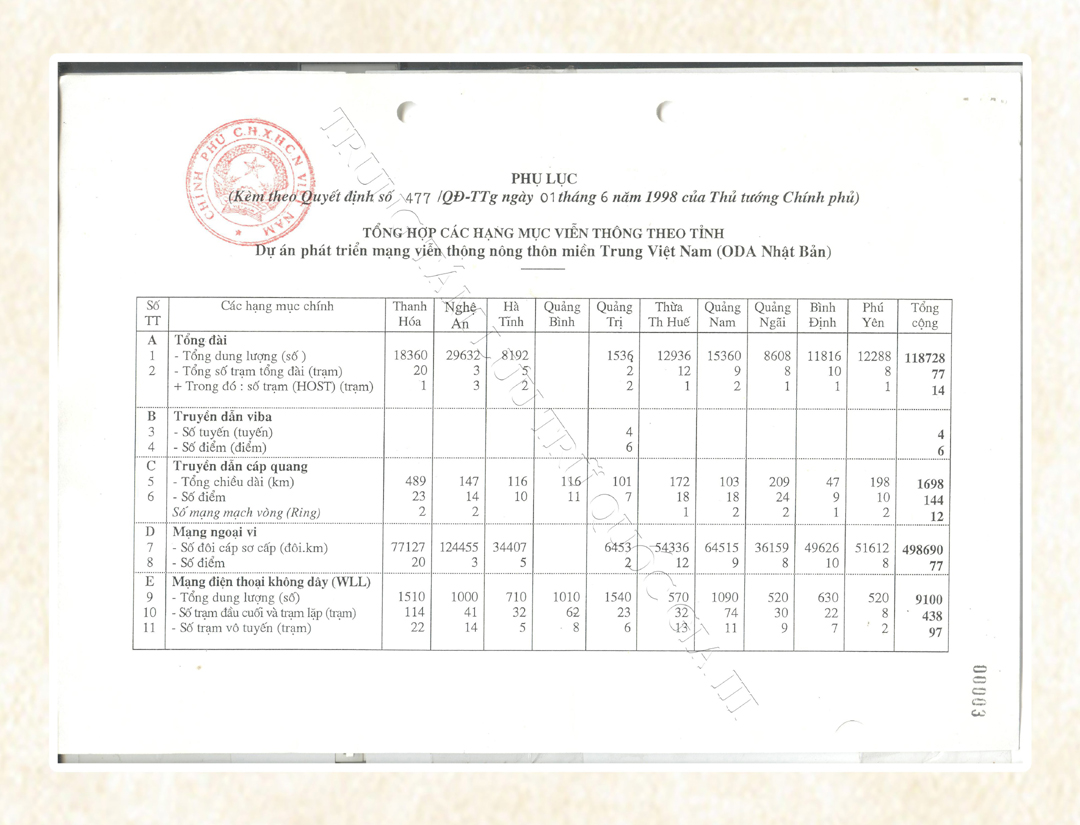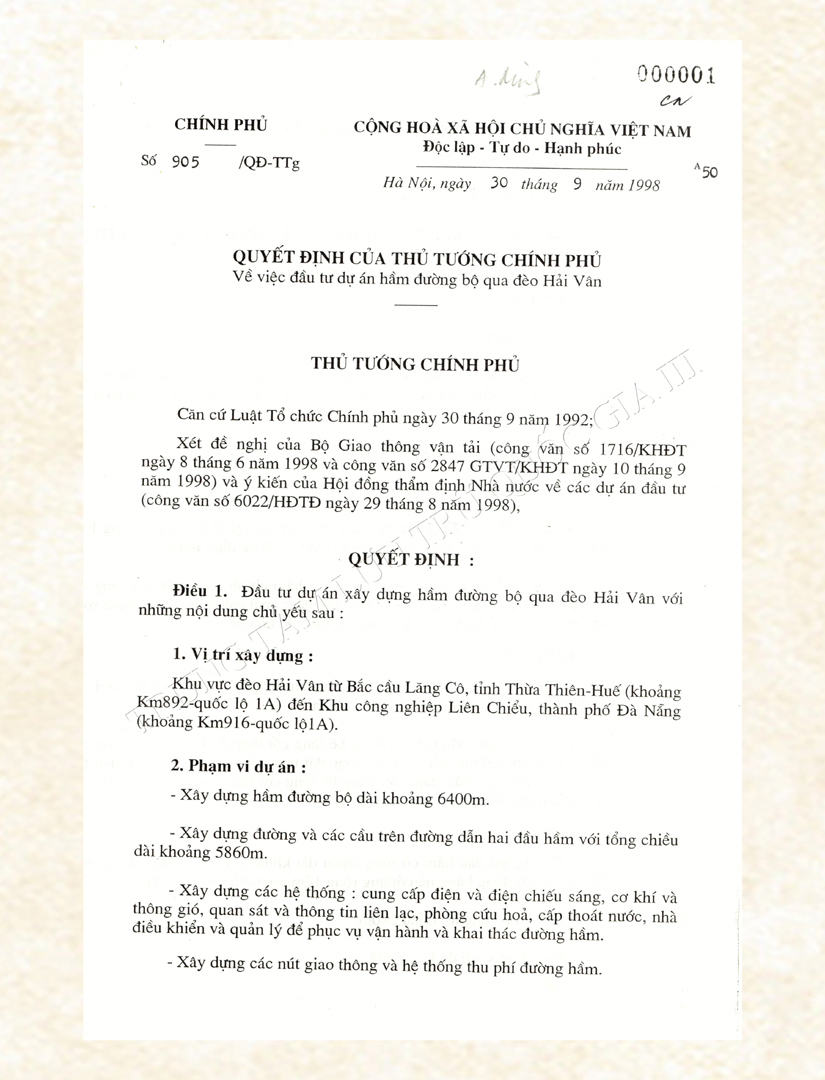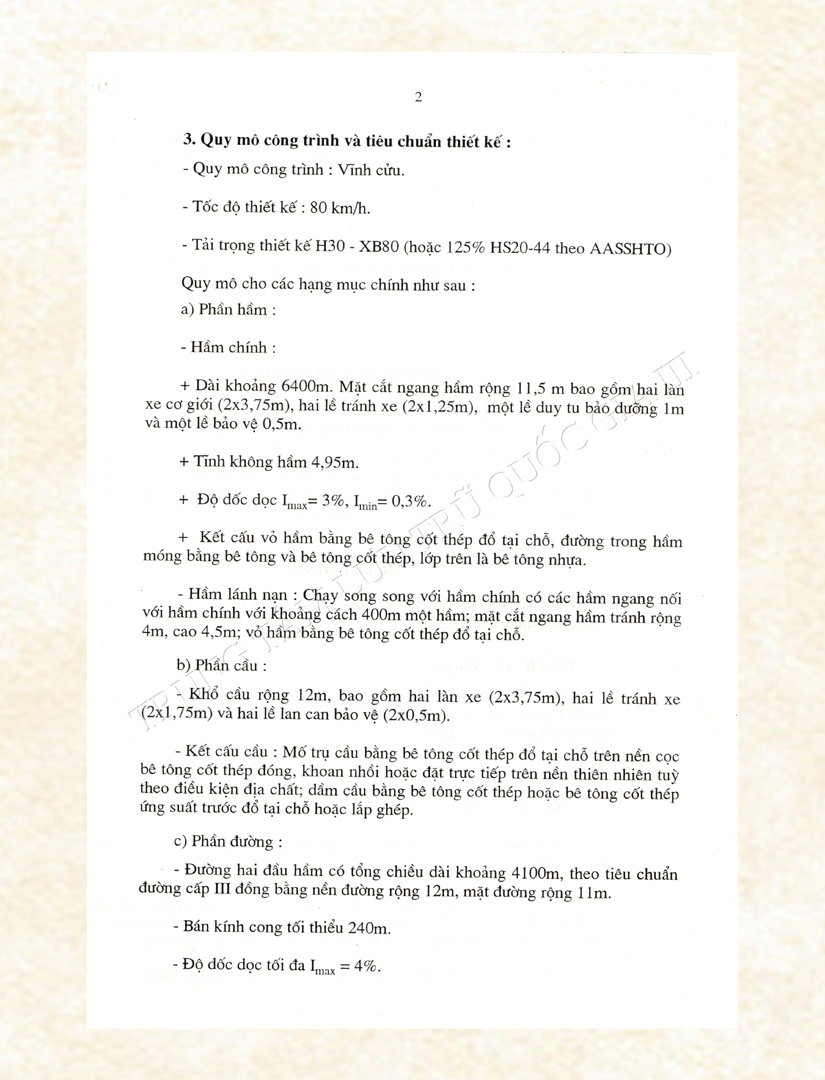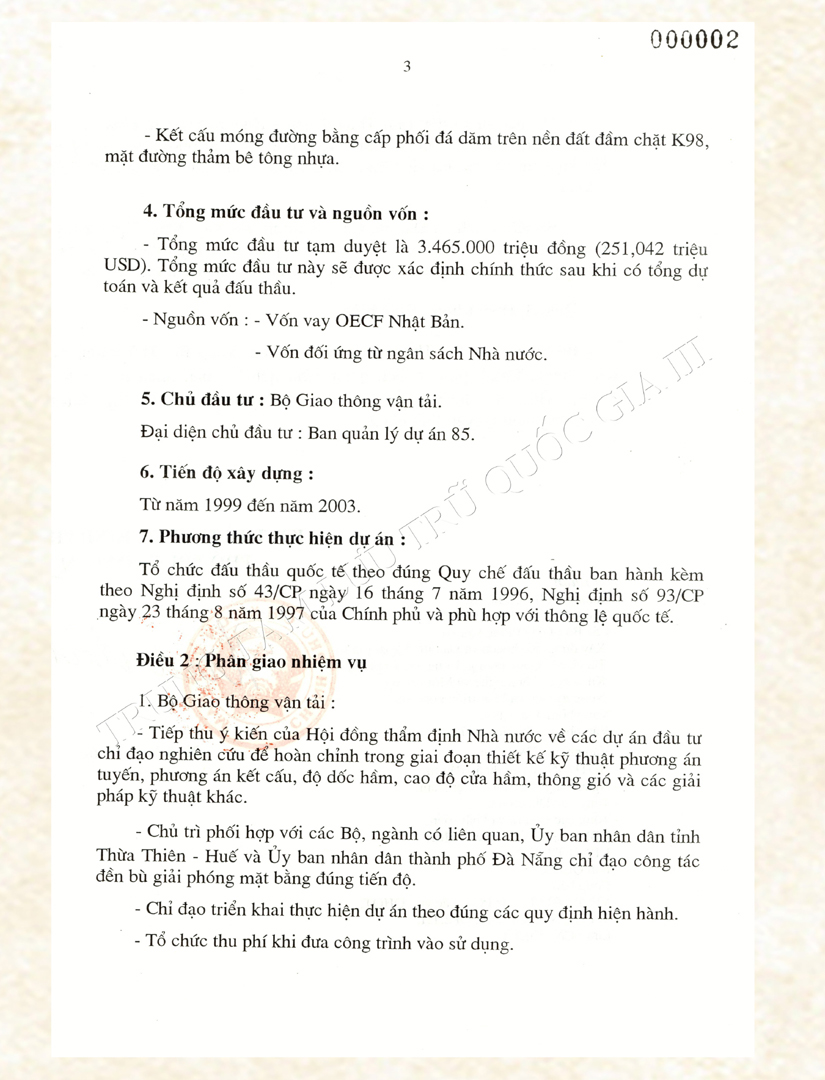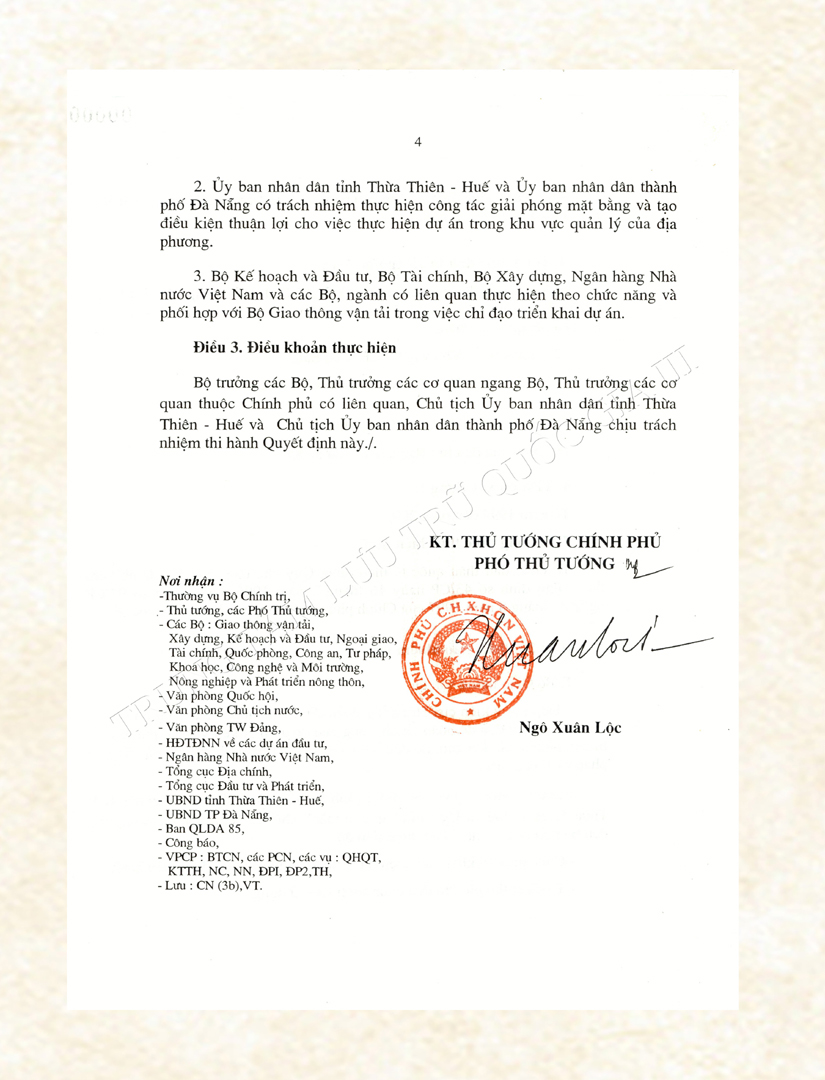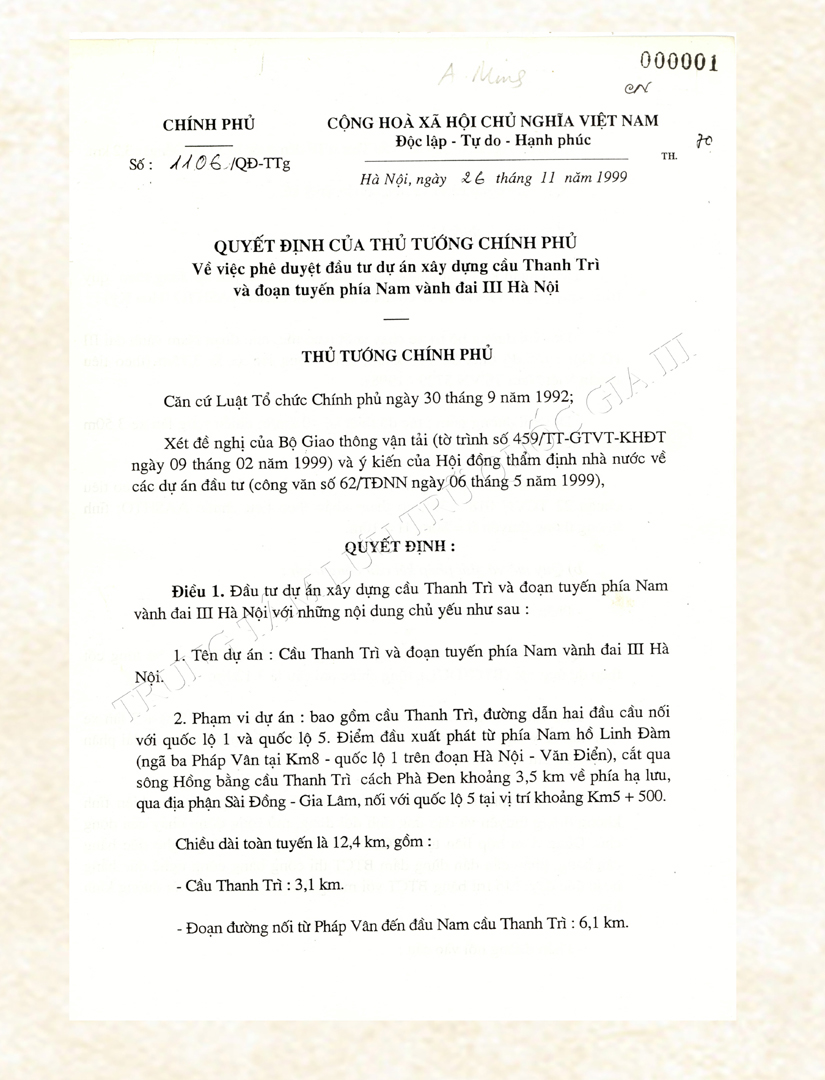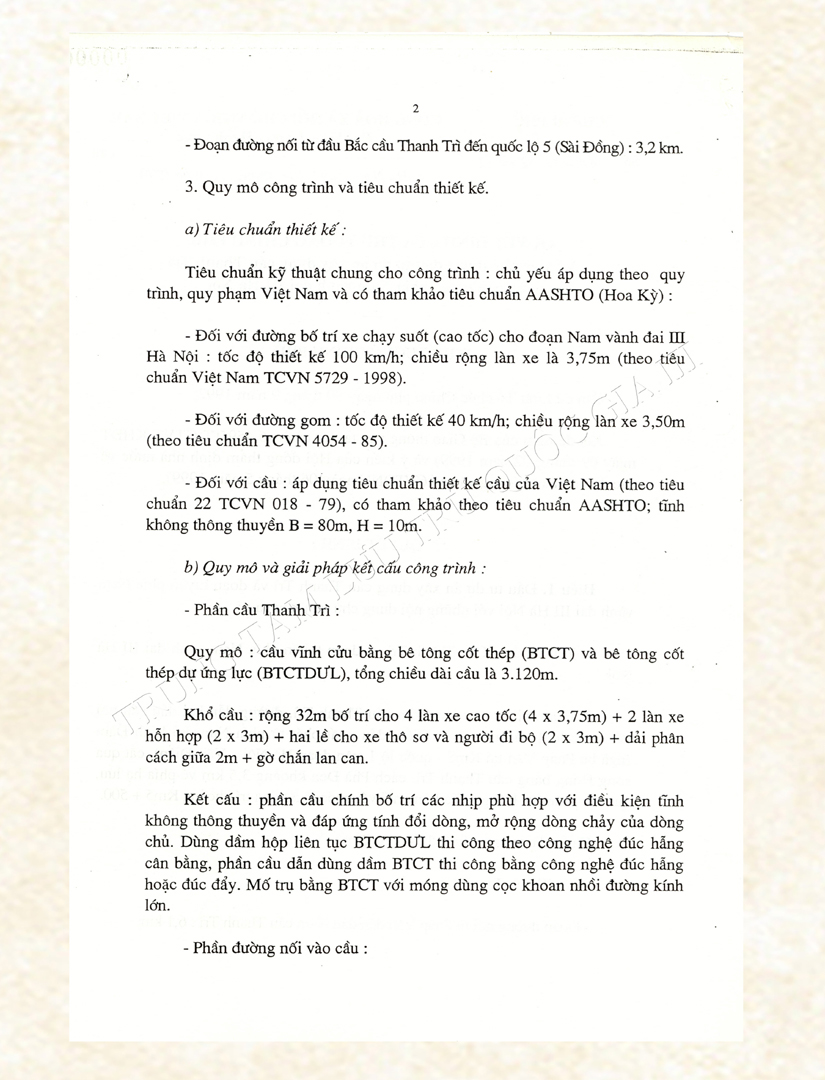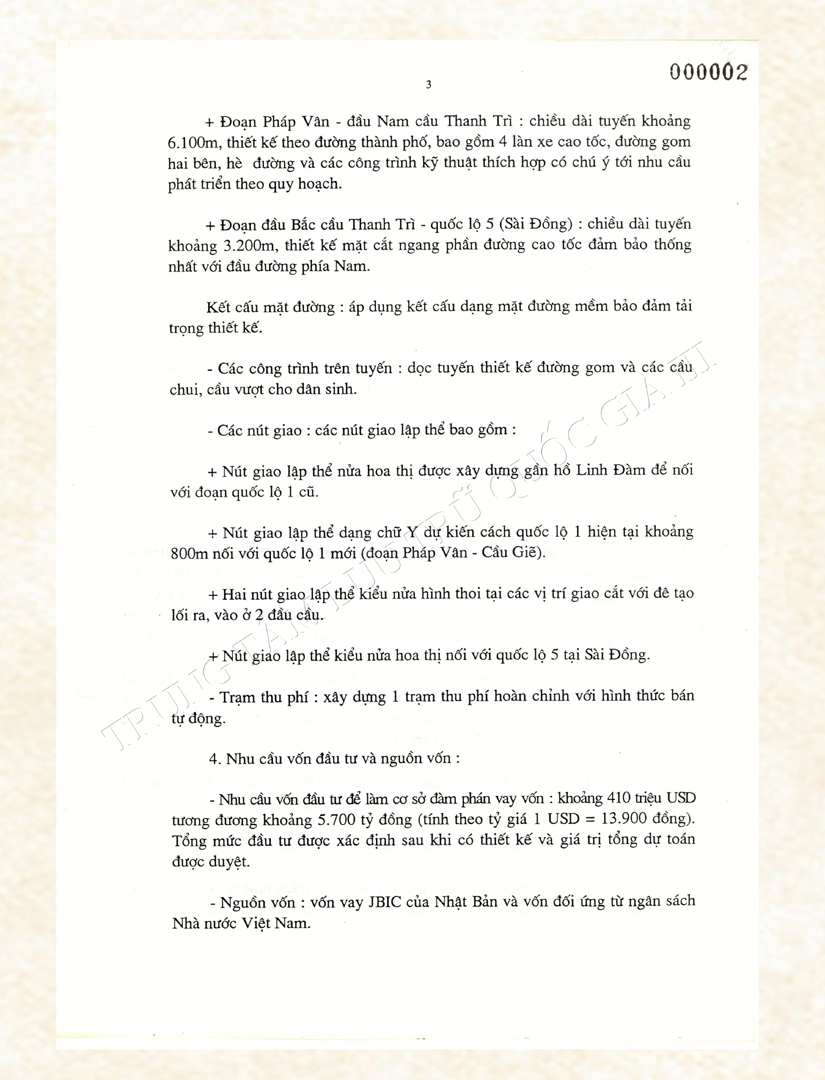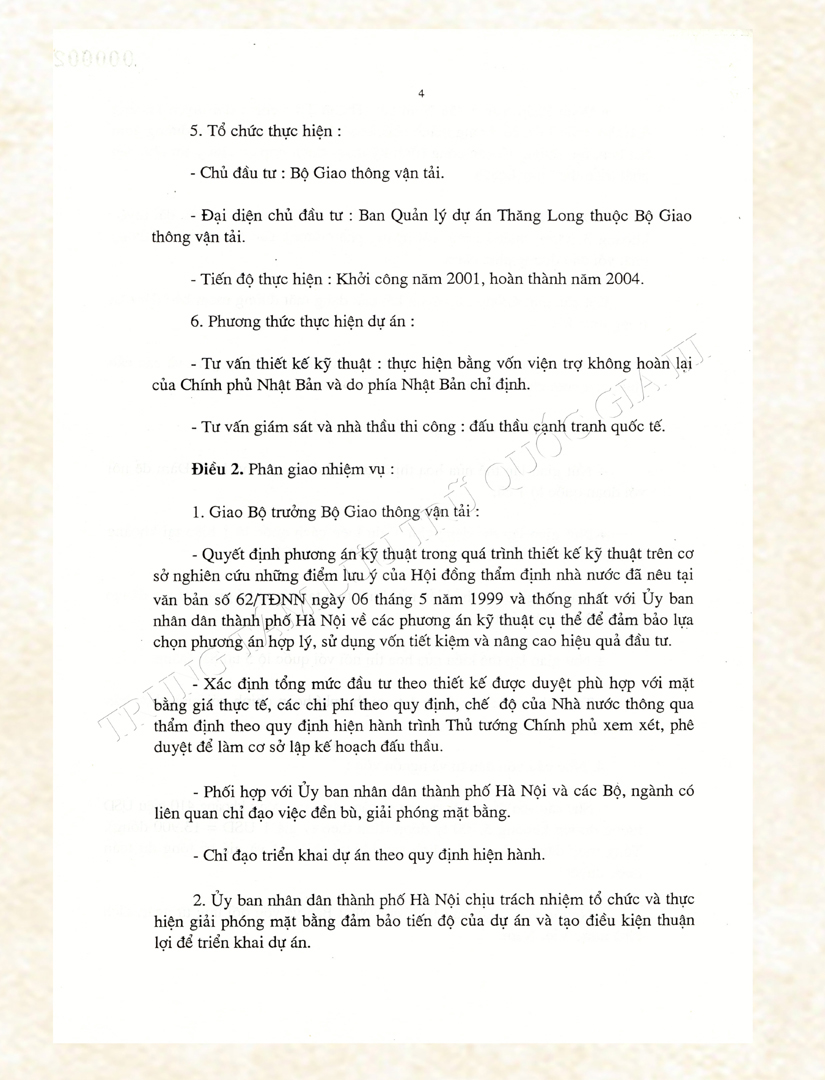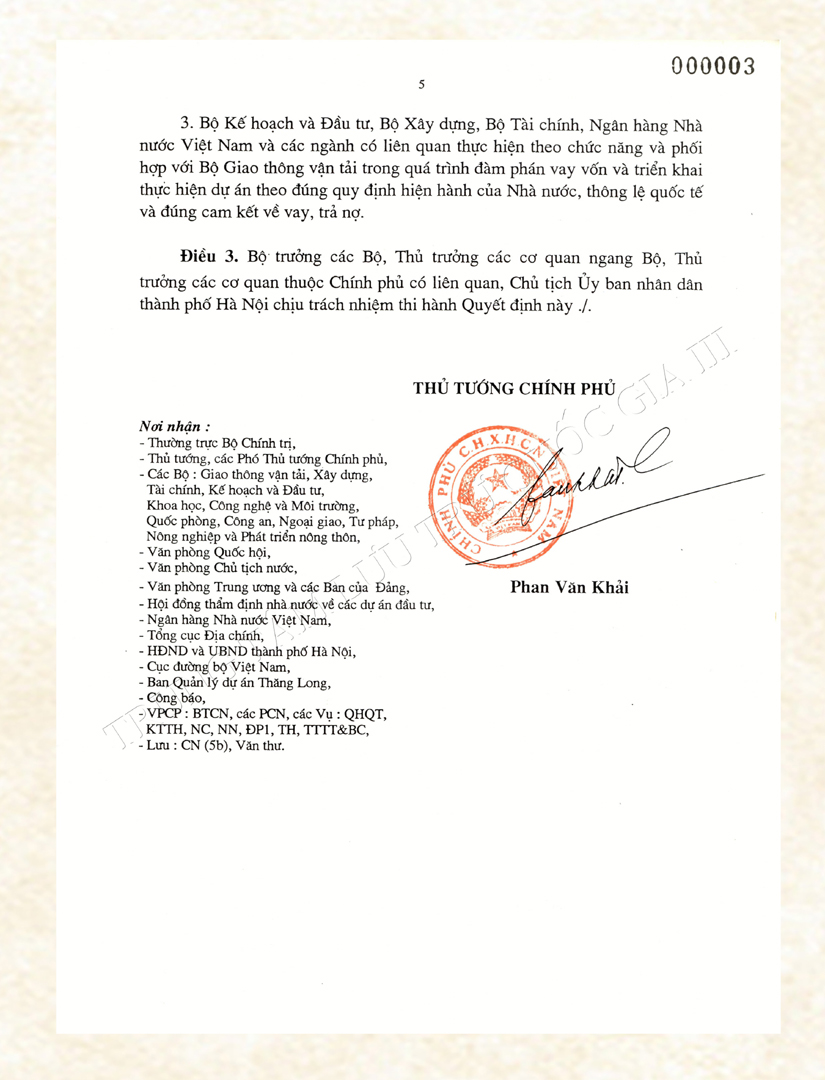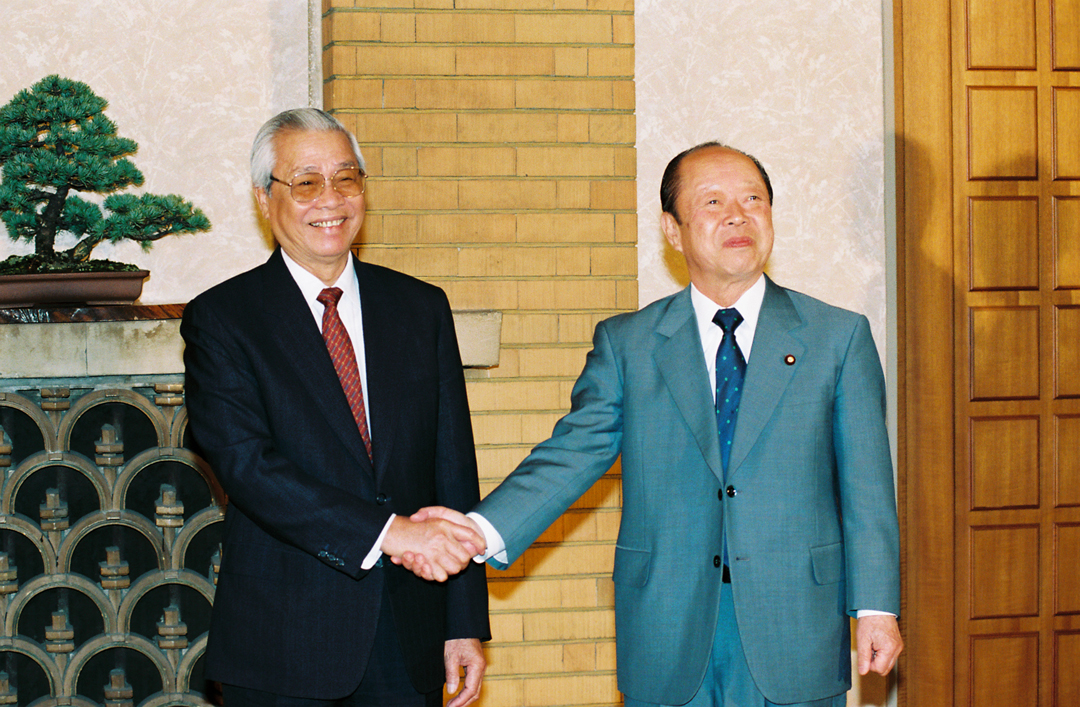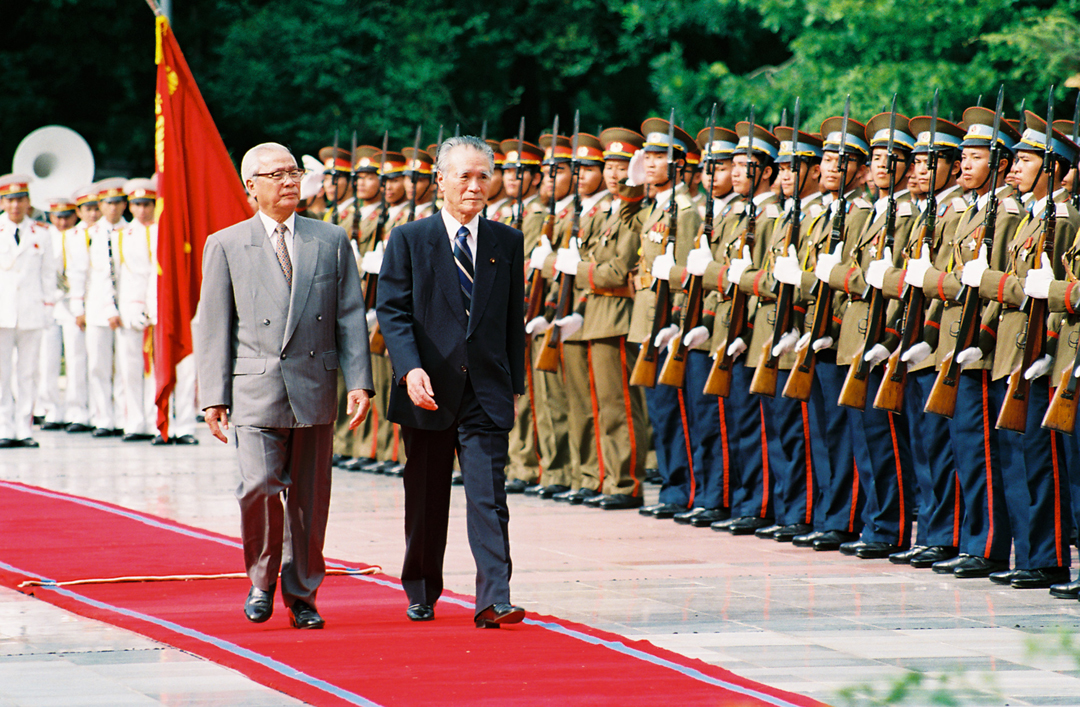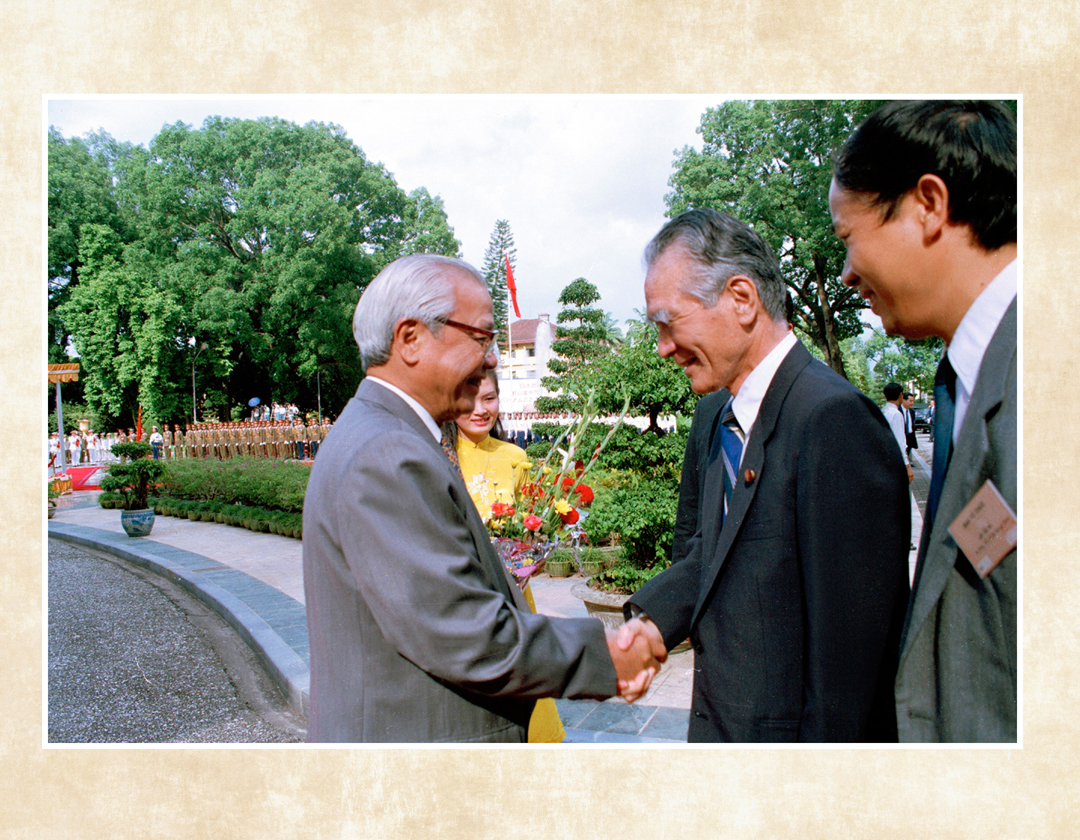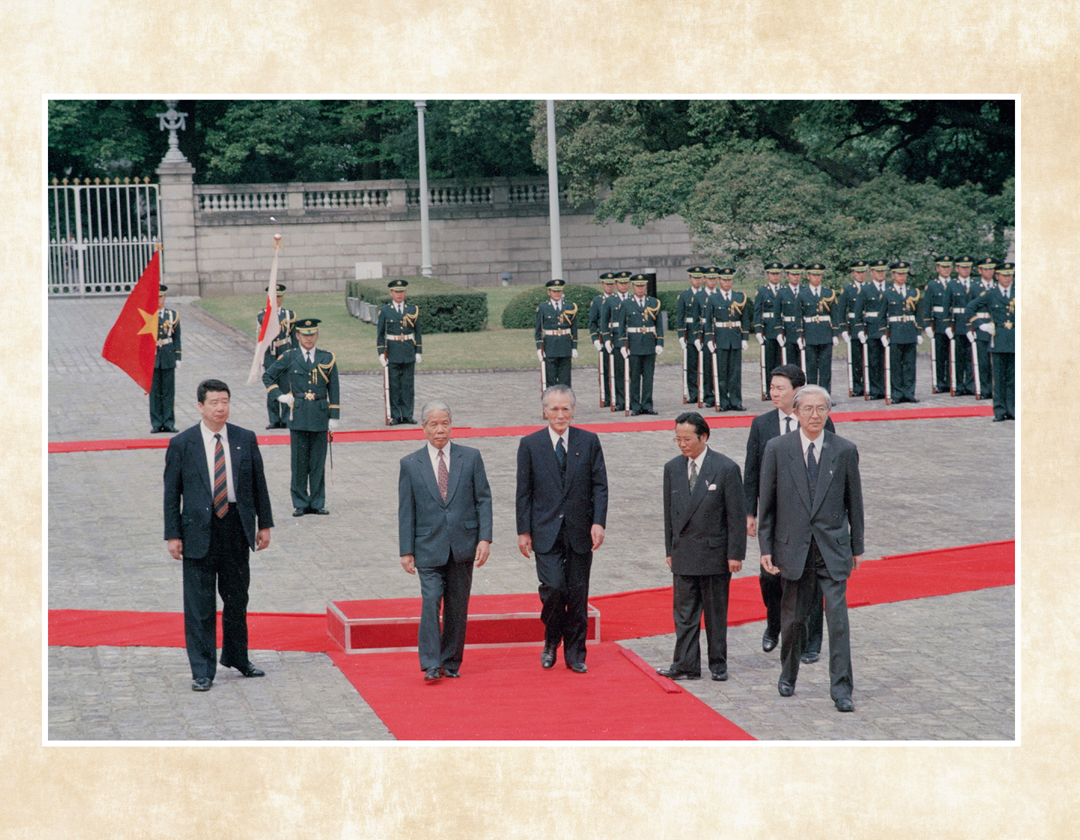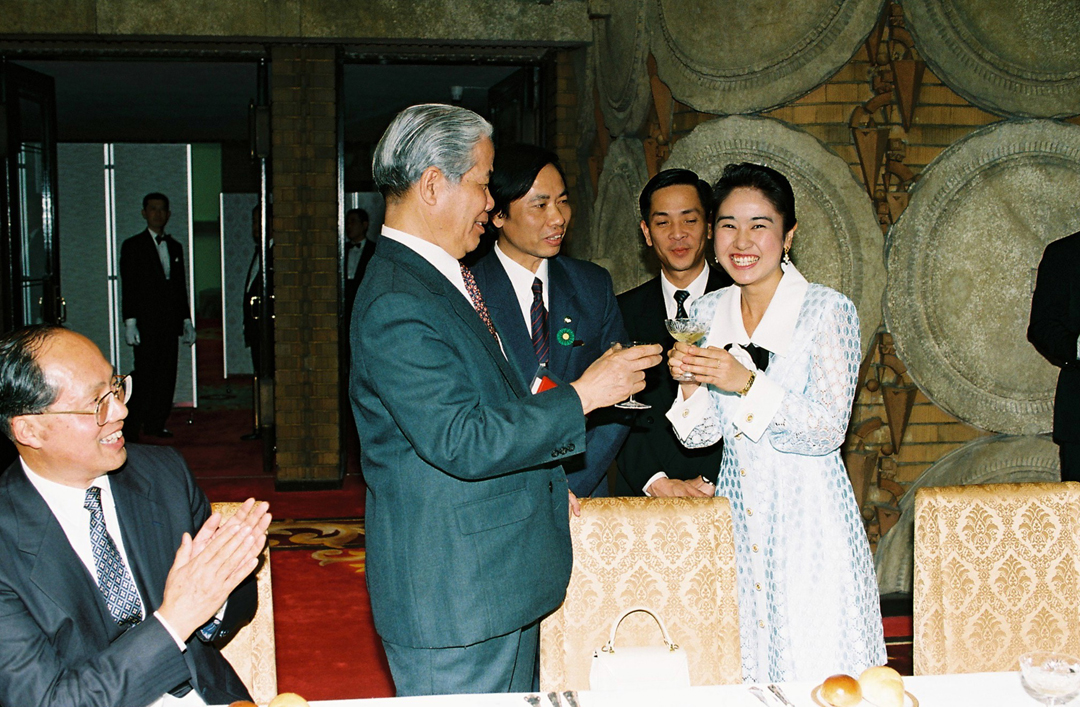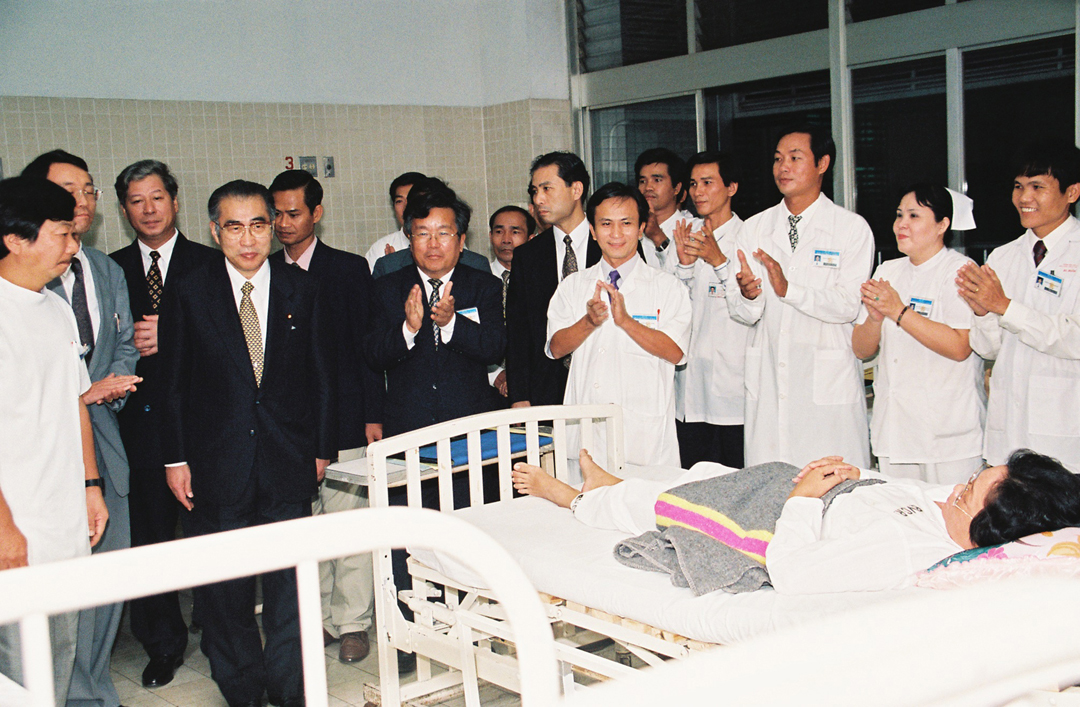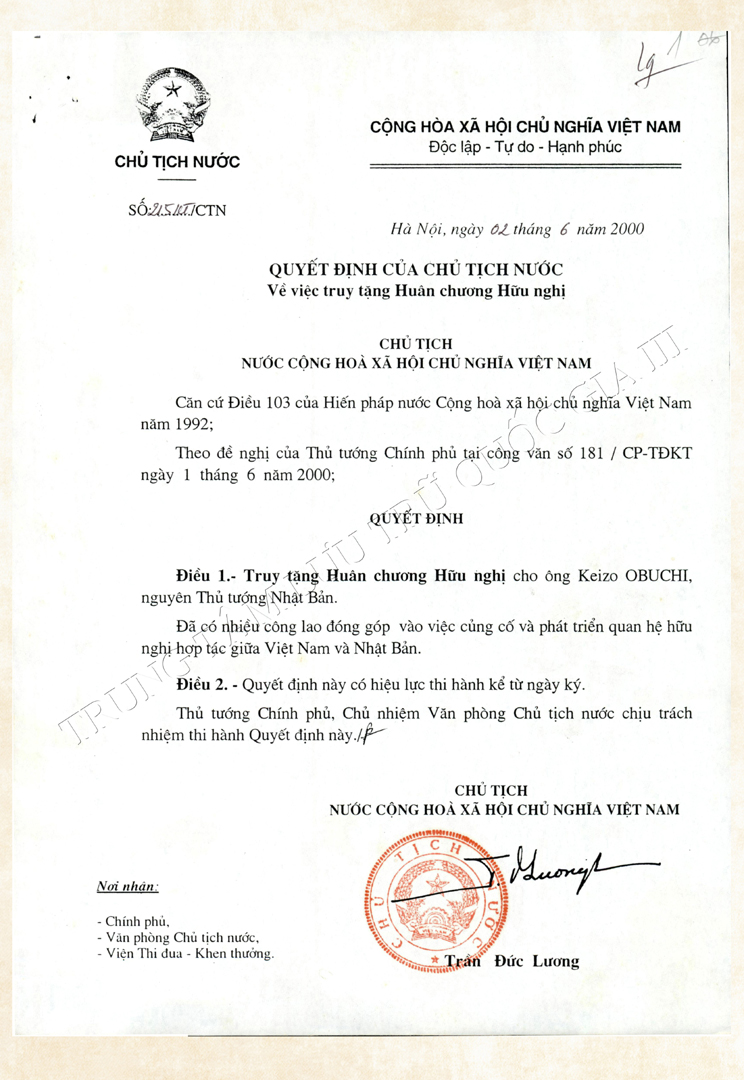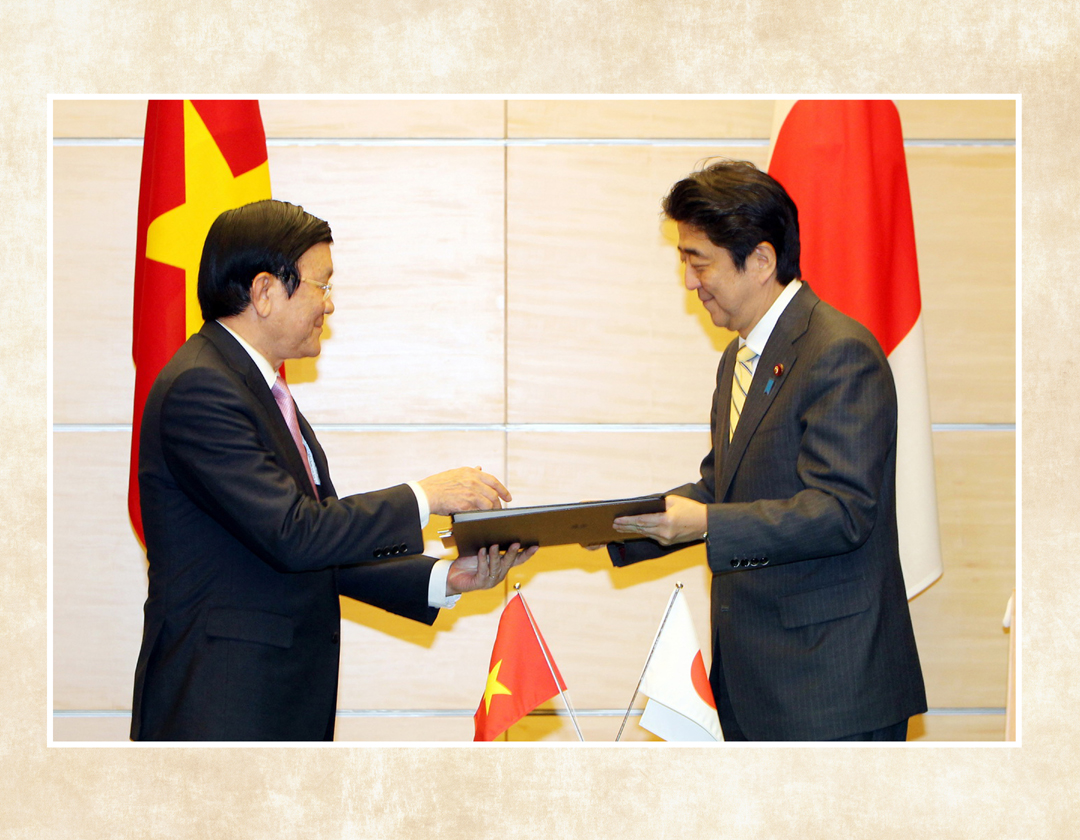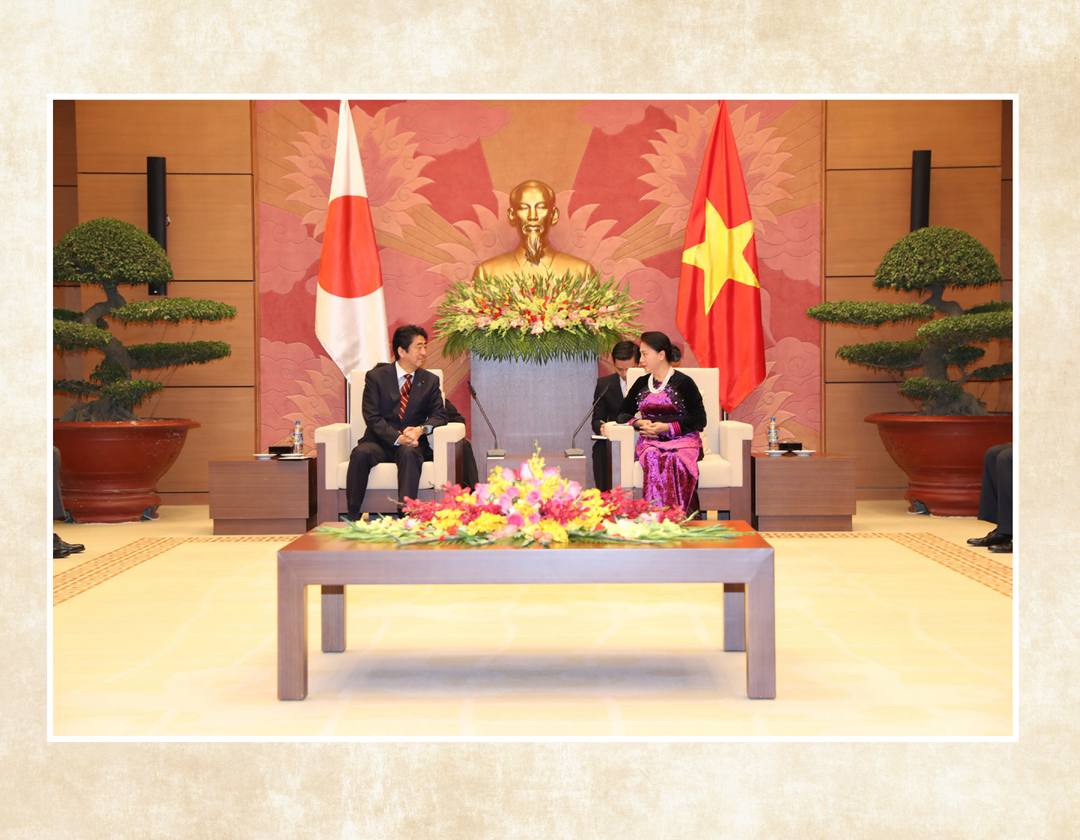Ⅳ. Vietnam and Japan: Old Partners, New Partnership
The Beginning of the Exchange
On this basis, the Japanese government requested that the Vietnamese government would allow the opening of a Japanese embassy in Hanoi. North Vietnam demanded that negotiations for resolving the “unsolved problem” should first be realized. 2 years of negotiations between Japan and North Vietnam ensued at Vientiane, the capital city of Laos.
1. Exchange of Notes Concerning the Establishment of Diplomatic Relations Between Japan and the Democratic Republic of Vietnam
2. Signing the Exchange of Notes Concerning the Establishment of Diplomatic Relations
Mr. Yukio Imagawa, who provided this photograph, took on successive positions, including that of the Charge d'Affaires ad interim of Japan to Vietnam and that of the Ambassador of Japan to Cambodia. The signatory authority of the Vietnamese side, Võ Văn Sung, later served as the Ambassador of Vietnam to Japan.
3. Joint Statement for the Establishment of Diplomatic Relations Between Japan and Democratic Republic of Vietnam
4. Submission to the Cabinet Meeting, Regarding the Exchange of Letters Between Japan and Democratic Republic of Vietnam, Concerning the Grant for Economic Revitalization and the Development in Democratic Republic of Vietnam
The “unsolved problems” discussed in Vientiane were primarily issues regarding Japanese grants of economic cooperation for the Democratic Republic of Vietnam. A similar funding was already given to the Republic of Vietnam (South Vietnam), with which Japan had officially instituted diplomatic relations during that period. The two governments had more than 20 official and unofficial meetings, and finally, on October 6, 1975, they reached an agreement on an endowment of 13.5 billion yen.
The document shown here is the one submitted to the Cabinet Meeting with respect to the exchange of letters concerning the grant for economic revitalization and development (dated 7th October) and a part of its attached documents. Submission to the Cabinet Meeting refers to the call for the meeting for a matter that requires a decision by the Cabinet at the Cabinet Meeting by a minister who is in charge of the issue. When approved by the Cabinet Meeting, it is authorized as a “Cabinet Decision.” The presented document was submitted by the Minister of Foreign Affairs, and prior to the submission, as one can see from the hand-written notes in the margin of the page, it was agreed upon by related ministries, including the Ministry of Finance, the Ministry of International Trade and Industry, the Ministry of Agriculture and Forestry, and the Economic Planning Agency. The signing was commissioned to Kiyoshi Suganuma, then the ambassador extraordinaire and plenipotentiary of Japan to Laos.
A draft for the Cabinet Decision, which would be the agenda of the Cabinet Meeting, and related reference materials are shown here. Other than these, the draft version of the Exchange of Notes (Japanese and French versions) is attached to the original records.
5. Exchange of Notes between Japan and the Democratic Republic of Vietnam, Concerning the Grant for Economic Revitalization and Development in Democratic Republic of Vietnam
The Exchange of Notes was signed on October 11, 1975, in Hanoi by Kiyoshi Suganuma, then ambassador extraordinaire and plenipotentiary of Japan to Laos, and Hoàng Văn Tiến, who was, at the time, the Vice-Minister of Foreign Affairs. This paper documented that at first, Japan would provide a grant of up to 8.5 billion yen (out of 13.5 billion grant in total) which would be spent in purchasing heavy machinery used for farmland cultivation and public works provided by corporations owned by Japanese nationals.
The document introduced here is the one signed by the Vietnamese side and handed to Japan. It is now kept by the Ministry of Foreign Affairs, Japan.
6. Decision on the Appointment of a Vietnam Ambassador to Japan
The signing of the Paris Peace Accords on ending the war and restoring peace in Vietnam in January 1973 opened a new phase in Vietnam–Japan relations. After signing the joint declaration on establishing diplomatic relations on September 21, 1973, Vietnam and Japan officially opened embassies in Tokyo and Hanoi, respectively, in 1975. On April 29, 1976, the Standing Committee of the National Assembly of the Democratic Republic of Vietnam enacted Decision No. 120/NQ/QH/K5, which approved Nguyễn Giáp as the first Ambassador Extraordinaire and Plenipotentiary to Japan.
The record was originally maintained in the collection of the Standing Committee of the National Assembly. It was subsequently transferred to National Archives Center No. 3 under the State Records and Archives Department of Vietnam for long-term preservation.
7. Appointment of the Ambassador of Japan to the Socialist Republic of Vietnam, Associated with the Establishment of the Japanese Embassy
The “Procès-Verbal,” a signed agreement that resulted from the 2-year negotiation in Vientiane, documented the following points: (1) The two countries would sign an Exchange of Notes concerning the grant of 8.5 billion yen for economic cooperation, (2) the remaining of the 5 billion yen endowment would be negotiated after the opening of the Japanese Embassy in Hanoi, and (3) the North Vietnamese government would agree with the opening of the Japanese Embassy in Vietnam on October 11, 1975. As such, the inauguration of the Japanese Embassy was agreed to be simultaneous with the grant for economic cooperation. After this development, Yukio Imagawa was assigned as a Chargé d'affaires ad interium to the Democratic Republic of Vietnam and started his work establishing the Embassy in Hanoi.
At the Cabinet Meeting on January 30, 1976, Takaaki Hasegawa, Consul-General of Japan in Honolulu, was appointed the Ambassador Extraordinaire and Plenipotentiary to Vietnam. The document shown here is the Cabinet Document dated 8th of July 1976 that mandated Ambassador Hasegawa to go to Vietnam. “Kaoh,” stylized signatures indicating approval by each Minister, are seen on the first page, and Hasegawa’s biography is attached to the last page.
In addition, although Vietnam was divided into North and South after July in 1954 when the Geneva Accords was signed, the reunification of the nation was realized in July 1976, one year after the end of the Vietnam War, and the country renamed itself the Socialist Republic of Vietnam.
National Support for Development
Following the grant for economic cooperation in 1975–1976, the Japanese government provided the first yen loan to the Socialist Republic of Vietnam in 1978. After a decade-long suspension of the ODA, Japan resumed yen loans toward Vietnam in November 1992, a year after the Paris Peace Accord was effected in October 1991. Currently, Japan is the top ODA donor to Vietnam.
In the 21st century, bilateral relations between the two nations have developed increasingly. In December 2003, the Vietnam–Japan Joint Initiative was launched to improve the business environment in Vietnam. Then in October 2006, the joint statement “Toward a Strategic Partnership for Peace and Prosperity in Asia” was pronounced, and in In December 2008, the Bilateral Economic Partnership Agreement was finalized. Furthermore, in March 2014, the top leaders of the two countries agreed to upgrade bilateral relations to “Extensive Strategic Partnership for Peace and Prosperity in Asia” and mutually promised closer and deeper collaboration in a wide range of areas, including politics, economics, national security, culture, and human exchange.
This section displays the records of the first Japanese Yen Loan in 1978 and the various projects funded by the Japanese funding in the 1990s.
1. Submission to the Cabinet Meeting Regarding the Exchange of Letters Between Japan and the Socialist Republic of Vietnam, Concerning the Yen Loan
As mentioned above, the Japanese government provided the first yen loan to the Vietnamese government in 1978. The records shown here are the Submission to the Cabinet Meeting and the attached documents for reference.
Like the Exchange of Notes concerning the grant for economic cooperation mentioned earlier, this material was also submitted by the Minister of Foreign Affairs. The margin notes mention that, prior to the submission of the material, the negotiation was made among the concerned ministries, including the Ministry of Finance, the Ministry of International Trade and Industry, and the Ministry of Agriculture and Forestry.
According to the attached documents, a loan of up to 10 billion yen would be provided to the Vietnamese government to improve its balance of international payments. It would be used for the procurement of products and associated services on the condition that the suppliers would not be limited to Japanese nationals and could belong to other countries.
2. Exchange of Notes Between Japan and the Socialist Republic of Vietnam, Concerning the Yen Loan
This is the Exchange of Note concerning the first yen loan to Vietnam, signed by the Vietnamese Vice-Minister of Foreign Affairs on July 7, 1978. The original document is kept by the Japanese Ministry of Foreign Affairs.
3. Decision on Approving the Central Vietnam Rural Telecommunication Network Project
Telecommunications is not only a significant factor of economic development but also a key economic sector in itself. Thus, improving the telecommunication system in rural areas has become an urgent requirement for Vietnam’s process of national industrialization and modernization.
To realize the objectives set for developing telecommunication systems in rural areas, Ngô Xuân Lộc, the Deputy Prime Minister of the Socialist Republic of Vietnam signed the Decision No. 447/QĐ-TTg on June 1, 1998, approving the Central Vietnam Rural Telecommunication Network Project, which was financed by an ODA loan from the Japanese government for fiscal year 1997.
The project has made profound contribution in terms of the restructuring of the economy, the enhancement of production, the alleviation of poverty, and raising the intellectual standards of the Vietnamese people. It has thus helped in eradicating the gap between rural and urban areas and has aided in ensuring better communication from the central to local governments and vice versa.
This record belonged to the collection of the Prime Minister’s Office, and it is now kept in National Archives Center No. 3 under the State Records and Archives Department of Vietnam.
4. Decision on Approving the Hải Vân Tunnel Construction Project
Hải Vân pass is situated on National Highway No. 1, which connects Hue and Da Nang. It constitutes a strategic pass in the East–West Corridor linking central Vietnam with Laos and Thailand. However, owing to its difficult terrain, this is one of the most dangerous sections of the highway.
To shorten travel time as well as to ensure safe passage and make a contribution to socio-economic development, Deputy Prime Minister Ngô Xuân Lộc signed the Decision No. 905/QD-TTg on September 30, 1998, approving the Hải Vân Tunnel Construction Project which was mainly financed by a loan provided by the Overseas Economic Cooperation Fund (OECF) of Japan. The four-page decision specifically identified the project location, scale of construction, design specifications, project duration, etc.
The document was maintained in the Prime Minister’s Office collection, and it is now preserved in National Archives Center No. 3 under the State Records and Archives Department of Vietnam.
5. Decision Approving the Red River Bridge Construction Project
By the early 2000, there were only three bridges across the Red River connecting Hanoi Capital with the northern and southern provinces through National Highway No. 1 and No. 5. To reduce traffic congestion and to promote socio-economic development in the Hanoi area, on November 26, 1999, Prime Minister Phan Văn Khải signed the Decision No. 1106/QD-TTg based on the Ministry of Transportation’s proposal. This Red River Bridge Construction Project (or Thanh Trì Bridge) and the building of the southern portion of Hanoi Ring Road No. 3 were financed by a loan from the Japan Bank for International Cooperation (JBIC).
The total length of the route is 12.4 kilometers and includes Thanh Trì Bridge over the Red River and the road connecting the north point of the bridge with National Highway No. 5.
The bridge opened for public use in February 2007. It is now the longest among seven viaducts in the Hanoi area that connect the two sides of the Red River.
The document belonged to the Prime Minister’s Office collection, which is now preserved in National Archives Center No. 3 under the State Records and Archives Department of Vietnam.
Top Level Exchanges
Since the visit of Võ Văn Kiệt as the first prime minister of the Socialist Republic of Vietnam in 1993 to Japan and the reciprocal visit to the Socialist Republic of Vietnam by Tomiichi Murayama as the first prime minister of Japan to visit Vietnam in 1994 after the establishment of diplomatic relations, Japan and the Socialist Republic of Vietnam have progressively strengthened their ties, and VIPs mutually visit almost every year. Here are some photographs of such top level exchanges between the two countries.
1. First Visit to Japan by the Prime Minister Võ Văn Kiệt, Socialist Republic of Vietnam
In March, 1993, Mr Võ Văn Kiệt visited Japan for the first time as the prime minister of the Socialist Republic of Vietnam. Prime Minister Kiichi Miyazawa welcomed him and celebrated this moment as “the beginning of a new era for Japan and Vietnam.” Miyazawa also praised the Doi Moi policy of transforming Vietnam’s planned economy to a market economy and of projecting its openness to the international community, an effort initiated by Vietnam since 1986. The Japanese premier also announced his country’s support for this Vietnamese policy. In addition, the Japanese government announced a plan to dispatch research groups for economic cooperation between the two countries and to offer a large-scale Yen Loan. Prime Minister Kiệt strongly confirmed that the Vietnamese government would continue the Doi Moi policy.
The photo introduced here depicts Prime Ministers Miyazawa (right) and Kiệt (left) shaking hands at the beginning of the summit meeting held on 25 March. This photo is a part of “the special collection of the successive prime ministers,” a collection of publicity photos dated from 1968 (Prime Minister Eisaku Sato) to 2000 (Prime Minister Keizo Obuchi). The collection was originally kept by the Cabinet Public Relations Office.
2. Official Visit to the Socialist Republic of Vietnam by Tomiichi Murayama as the First Japanese Prime Minister
Prime Minister Tomiichi Murayama visited four South East Asian countries from August 23 to 29 in 1994. He was the first Japanese Prime Minister to visit the Socialist Republic of Vietnam, and this part of his tour attracted most of the spotlight. Furthermore, it was very timely because the Association of South-East Asian Nations (ASEAN) had just decided that Vietnam would be inducted as a full member of the association from the following year. Also, many people expected that the normalization of the diplomatic relations between the USA and Vietnam would be soon realized.
In the summit meeting with Prime Minister Võ Văn Kiệt, Prime Minister Murayama referred to a new plan of 7.7 billion yen-loan for improving industrial infrastructures such as roads, ports, and railways, and mooted a scheme to start regular meetings on political and security issues at the vice-foreign minister level. The two countries agreed. In addition, Japan announced the “Friendship Plan for Japan and Indochina” to invite 750 young people altogether from Cambodia, Laos, and Vietnam in 5 years starting from 1995 (500 persons from Vietnam).
The photo introduced here shows Prime Ministers Kiệt (left) and Murayama (right) reviewing the Guards of Honour at the Welcome ceremony.
3. Visit to Vietnam by Japanese Prime Minister Tomiichi Murayama
This photo was taken by a Vietnam News Agency (VNA) journalist named Minh Đạo during the official visit to Vietnam by Japanese Prime Minister Tomiichi Murayama in August 1994.
In this photo, the Prime Minister of the Socialist Republic of Vietnam Võ Văn Kiệt (left) is seen welcoming his Japanese counterpart Tomiichi Murayama (right) at the Presidential Palace on August 25, 1994. Tomiichi Murayama was the first Prime Minister of Japan who visited Vietnam since the establishment of the diplomatic relations between the two countries in 1973, taking bilateral relations to a new stage of development.
4. Visit to Japan by Đỗ Mười, Secretary General of the Communist Party of Vietnam
This photo was taken by a VNA journalist named Xuân Lâm during the visit to Japan by Đỗ Mười, Secretary General of the Communist Party of Vietnam in April 1995.
Đỗ Mười paid an official visit upon the invitation of Japanese Prime Minister Tomiichi Murayama. The event marked a significant development in Vietnam–Japan friendship relations because it was the first visit to Japan by a Secretary General of the Vietnamese Communist Party. In the photo introduced here, Secretary General Đỗ Mười (center left) is welcomed by Prime Minister Murayama (center right) at the front yard of the Japanese State Guest House on April 18, 1995.
5. Dinner party to welcome Đỗ Mười, Secretary General of the Vietnamese Communist Party
From April 17 to 21, 1995, Đỗ Mười, the Secretary General of the Communist Party, visited Japan for the first time as the highest leader of Vietnam. In the previous year, Prime Minister Tomiichi Murayama visited Vietnam and invited Đỗ Mười to come to Japan.
During his stay in Japan, Đỗ Mười met His Majesty the Emperor. After the summit meeting, Prime Minister Murayama and Secretary General Đỗ Mười attended the signing ceremony of notes on a 58 billion yen-loan exchanged between Kozo Igarashi, Chief Cabinet Secretary, and Nguyễn Mạnh Cầm, Minister of Foreign Affairs.
The photograph revealed here was taken at the welcome dinner party held at the prime minister's official residence. One of the invitees, Ayako Kobayasi (right), was the actor who played the main character of “Oshin,” an NHK TV drama that was broadcast in Vietnam and gained wide popularity.
6. Visit to Vietnam by Prime Minister Keizo Obuchi
In the midst of the Asian Financial Crisis (1997–1998), ASEAN-related summit meetings were held in Hanoi from December 15 to 16, 1998. Prime Minister Keizo Obuchi arrived at Hanoi and attended the ASEAN+3 (Japan, China, and Korea) Summit. In the meeting that was chaired by the Vietnamese Prime Minister Phan Văn Khải, the Japanese Prime Minister announced the “Obuchi Initiative” to support East Asian countries seriously hit by the financial crisis.
After attending the ASEAN-related meetings, Obuchi stayed in Hanoi on December 17 to conduct an official visit to Vietnam, met with three top leaders, including Prime Minister Phan Văn Khải, and discussed further development of bilateral relations. In the afternoon of the same day, he visited Hochiminh City as the first Japanese prime minister to do so after the reunification of Vietnam. He returned to Japan on December 18.
This is a photo taken when he visited the Chợ Rẫy Hospital in Hochiminh City, the largest national medical facility in the southern part of Vietnam. The hospital was constructed and upgraded by a Japanese ODA grant.
7. Decision to Award the Order of Friendship to Keizo Obuchi, the Former Prime Minister of Japan
Keizo Obuchi contributed significantly to the development of Vietnam–Japan relations as prime minister, the chairperson of the Japan–Vietnam Friendship Parliamentarians' Union, the head of the Japan–Vietnam Cultural Exchange Association, etc. For these achievements, he was awarded the Order of Friendship according to Decision No. 215KT/CTN signed by Trần Đức Lương, the President of the Socialist Republic of Vietnam, on June 2, 2000, a few weeks after Obuchi’s sudden death on May 14.
The document is now preserved in National Archives Center No. 3 under the State Records and Archives Department of Vietnam.
8. Visit to Japan by Vietnamese President Trương Tấn Sang
This picture was taken by a VNA journalist named Nguyễn Khang during the state visit to Japan from March 16 to 19, 2014, by the President of the Socialist Republic of Vietnam Trương Tấn Sang and his wife upon the invitation of the Japanese government.
On March 18, President Trương Tấn Sang (left) and Japanese Prime Minister Shinzo Abe (right) held a summit meeting and agreed to upgrade bilateral relations. After the high-level meeting, they released the “Japan–Vietnam Joint Statement on the Establishment of the Extensive Strategic Partnership for Peace and Prosperity in Asia.”
9. Visit to Vietnam by Japanese Prime Minister Shinzo Abe
VNA journalist named Trọng Đức took this photograph during Japanese Prime Minister Shinzo Abe’s official visit to Vietnam from January 16 to 17, 2017, upon the invitation of the Vietnamese counterpart Nguyễn Xuân Phúc.
On January 16, Prime Minister Abe (left) and the Chairperson of the Vietnamese National Assembly, Nguyễn Thị Kim Ngân (right), met together at the Office of the National Assembly. At the meeting, the two leaders agreed to further deepen and enhance bilateral cooperation.



